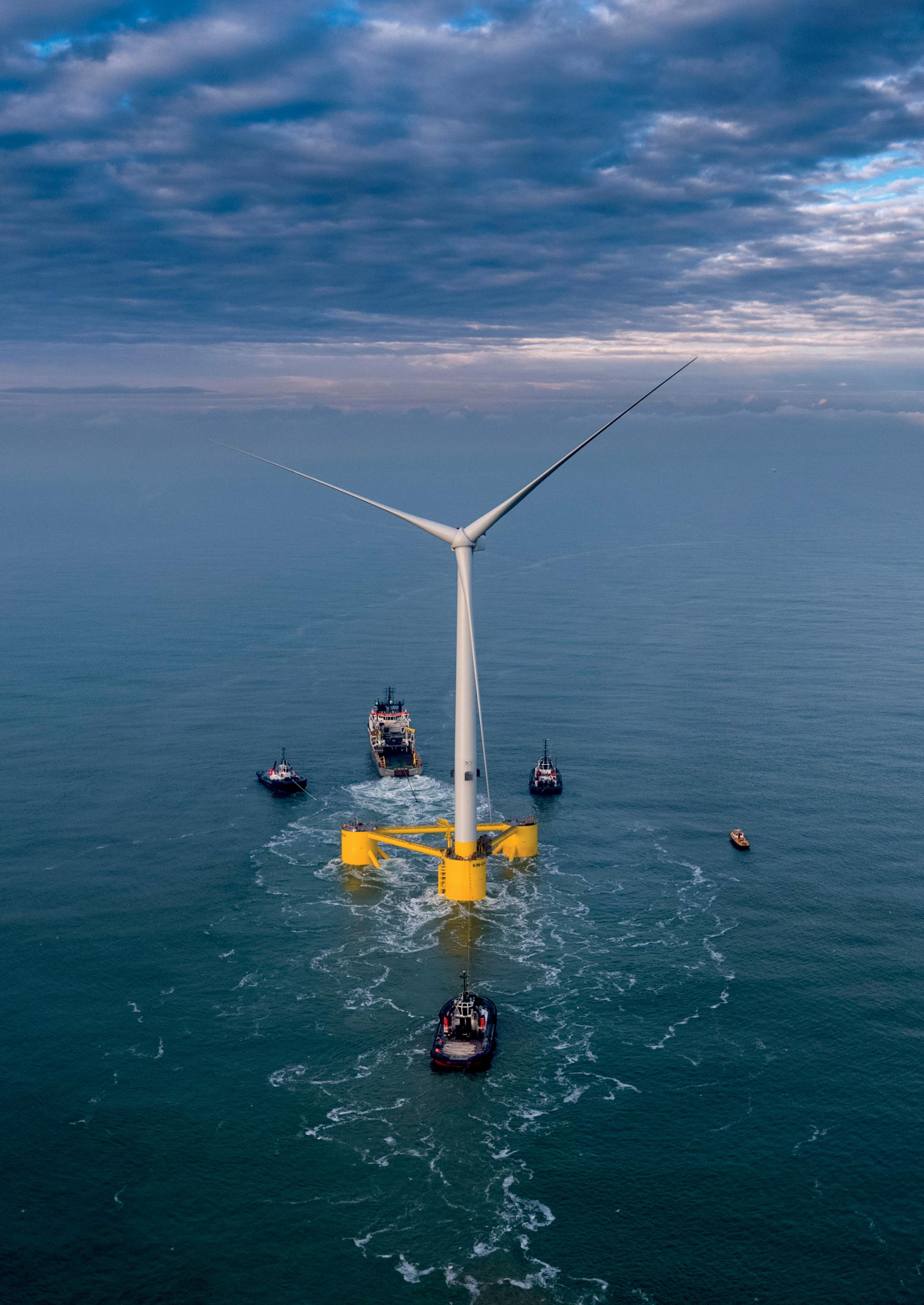
Why ‘NEGAWATTS’ will be pivotal for the energy transition


Why ‘NEGAWATTS’ will be pivotal for the energy transition


Your NEW all-in-one test solution to verify PV system performance and safety and expedite client reporting.
On-location I-V curve results: compare manufacturer I-V curve data to measured data instantly in the field, no laptop required
Automatic testing saves time: on-screen instructions provide an easy walkthrough of tests on a colour screen
Less time wasted on set-up: with “Keep the Leads” system, configuration of test leads is only required once
Wireless irradiance and temperature measurements: the IRR2-BT Irradiance Meter Pro communicates in real time with the SMFT-100 0
Critical testing features:
IEC 62446-1 compliant for full safety and system performance testing
Spend less time processing test results and compiling reports with TruTest™ Solar Data Management Software

•Quickly create inspections and reports compliant with IEC 62446-1.
•I-V curve analysis with easy pass/fail visuals; see changes in I-V curve over multiple site visits.

Ta
Dawes
The last financial year showed that the energy sector continues to innovate, challenge, and invest in new solutions for the nation’s future.
As many in the industry know the pace of change and growth needs to accelerate if Australia is to reach future goals in time. This was evident, and a keen topic of discussion, at the recent Australian Energy Week conference.
During the event, AEMO CEO, Daniel Westerman, AEMC Chair, Anne Collyer, and other industry experts urged the sector to take action before it's too late. Despite the challenge, and the puzzle of the transition, Ms Collyer said, “We all have pieces to contribute”.
This is a fitting analogy for the industry. The net zero by 2050 goal requires vast work, and every solution, no matter the scale, is beneficial.
The 23-24 Federal Budget, released in May, showcased the necessity for varied government support and investments, such as the $20 billion in funding announced for the Clean Energy Finance Corporation, the Hydrogen Headstart program, and the Net Zero Authority, as Australia’s energy sector continues to evolve.

In this issue of Energy, we discuss large-scale solutions, Australia’s growing wind industry, including offshore assets in Gippsland, and what’s ahead for New South Wales’ newly crowned national offshore wind zone.
The specified zone in the Hunter region includes over 1,850 square kilometres, and the DCCEW has estimated the area has the potential to generate 5GW of wind energy – enough to power 4.2 million homes. With
feasibility licence applications open until November, I’m sure we’ll continue hearing about more offshore wind proposals.
This edition also covers energy efficiency and storage – the building blocks supporting decarbonisation and grid stability – with an exclusive feature from the Climateworks Centre regarding the potential of 'negawatts', and ANU research on how solar hours heating can support regional locations with battery storage requirements.
It’s also been great to hear about from the ever-important energy workforce on the ground. This edition highlights Origin Energy’s Nick Bristol and his work on the Australia Pacific LNG project.
I’m excited to see where the next few months take the industry, and as always, if you have a story or project to share, I’d love to hear it.
Holly Tancredi Editor12 An introduction to CSIRO’s new Energy Director: Dr Dietmar Tourbier
30 ‘Negawatts’ will enable the energy transition in Australia


Why is building energy efficient infrastructure important? Due to physical infrastructure lasting 50-100 years, building it to be energy efficient will continue to pay us back for a very long time. This is because ‘negawatts’ – or the watts saved through energy conservation or energy-efficient choices – in buildings, transport and industry are the most cost-effective way to reach zero emissions.
34 Innovative, intelligent solutions for the energy transition

36 EN2024: Unparalleled networking and collaboration opportunities
14 Leading the charge in Australia's offshore wind industry
As Australia's transition to a sustainable and low-carbon energy future gains momentum, offshore wind continues to emerge as a crucial component of this transformation. Flotation Energy, a global offshore wind developer, is at the forefront of this movement and globally renowned for pioneering floating offshore wind and energy transition projects.
18 Winds of change: geotechnical innovation in wind farm construction
20 Retiring wind turbines: reuse, repurpose or recycle?
24 Precision flying speeds up connection works
26 The benefit of experience in extending the life cycle of wind turbines
28 The new horizon: Australia’s developing offshore wind industry
There’s something new taking shape on Australia’s coastlines. Wind power has been used in Australia for decades, but now in 2023 – supported with federal offshore electricity acts and regulations – offshore wind power is set to blow fossil fuels out of the water. Supporting this industry growth is the latest declaration of the Hunter region as the nation’s second offshore wind zone.
38 Storage: A ‘sweet spot’ lies in the distribution network
The challenge of decarbonisation rests on us all; industry, government, and households alike across Australia.
42 The technology solving Australia’s battery storage needs

44 Solar hours heating redefining regional battery storage requirements
Developing more sustainable and energy efficient ways to store and use energy does not always have to require fancy or complex technologies. A recent collaboration from the Australian National University and a regional Victorian town has had surprising and positive results in proving that moving electric hot water heating from nighttime to during solar hours has the potential to massively reduce required battery storage.
46 It’s the destination, not the journey: the federal strategy to reduce EV uptake barriers
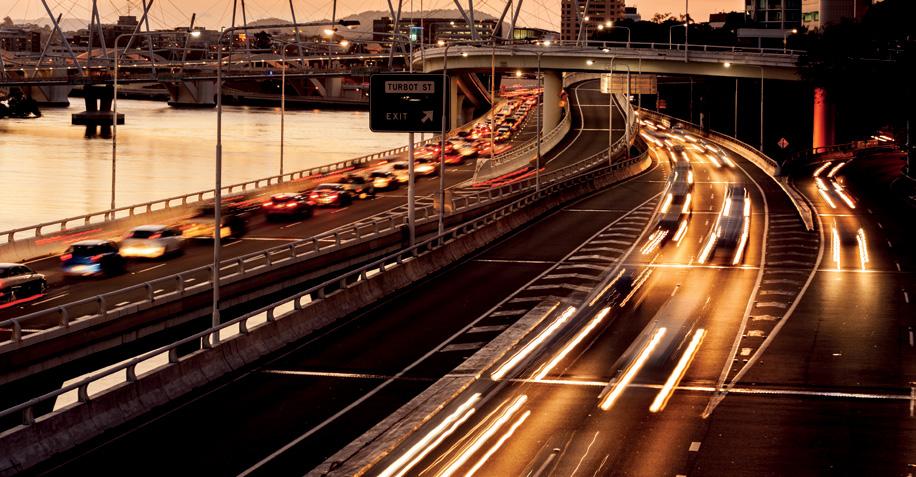
Evolving an entire transportation industry is no small feat. State and territory governments, leading energy organisations and experts have been working in recent years to ensure Australia’s passenger transport future is electric, but there is a piece missing from the puzzle. In April 2023, the Federal Government, after long industry and consumer consultation, released the country’s first Federal National Electric Vehicle Strategy. Finally outlining the work ahead to legislate a fuel efficiency standard and more, the strategy shares Australia’s plan to grow the uptake of electric vehicles (EVs).
48 Connecting EVs across Australia’s energy grids
1 Editor's Welcome
64 Features Schedule
64 Advertisers’ Index
NEWS
4 Financial close on VIC hydrogen plant
5 WA’s second big battery begins construction
6 $20.5 billion allocated to CEFC
7 Indigenous partnership to deliver green hydrogen project
52 Guaranteeing hydrogen some get up and GO
Most of us are familiar with the green and gold kangaroo or the Health Foundation tick. These quickly identifiable certification schemes are designed to give customers confidence in the product they are purchasing, with the assurance that the “premium” products they buy are what they are purported to be. Australia’s hydrogen Guarantee of Origin scheme would work in much the same way. The scheme is under development and will be an important tool in the policy toolbox to support the transition to renewable gas.
54 Solving challenges in high voltage power across the Australia Pacific LNG project
56 Taking biomethane from pipe dream to pipeline
60 From fossil to renewable: Australia's liquid fuel transition
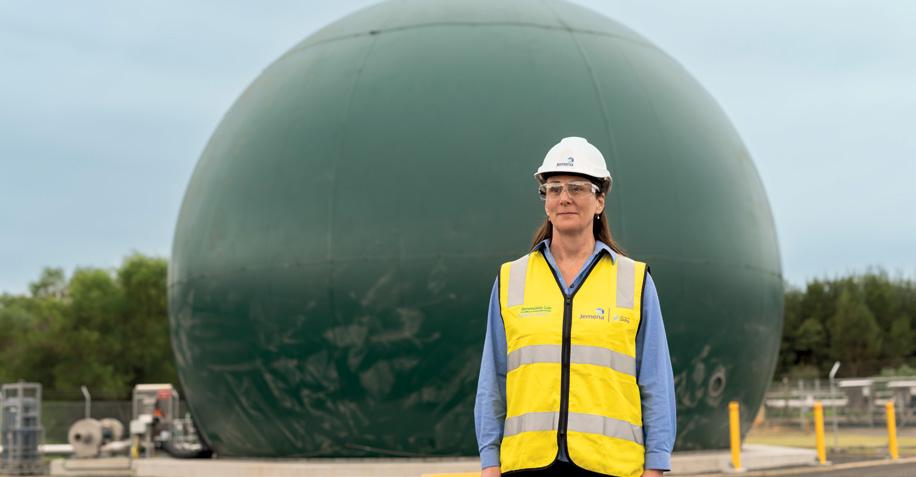
8 AEMO releases engineering priorities to ready NEM for renewables
8 ‘Big Bessie’ battery switched on
9 New FY – the perfect time to check the health of your super
10 Engineering climate solutions: CSE23
Australian Gas Infrastructure Group (AGIG) has reached financial close on the Hydrogen Park Murray Valley renewable hydrogen plant, a major milestone in the project’s development.

The Australian Renewable Energy Agency (ARENA) announced a $36.1 million commitment to AGIG for the 10MW electrolyser deployment in Wodonga, Victoria.
The project builds on ARENA’s existing work in renewable hydrogen and strong track record of delivering transformative projects in the energy transition in pursuit of net zero.
The Hydrogen Park Murray Valley project will produce renewable hydrogen to initially be blended into the local natural gas distribution network, owned by Australian Gas Networks, part of AGIG.
The facility will be located next to North East Water’s Wodonga Wastewater Treatment Plant. Once complete, the project will be the largest renewable hydrogen facility on the east coast and equal largest in Australia.
The renewable hydrogen produced will displace natural gas supplied to local customers and industry at blends of up to ten per cent, reducing carbon emissions with no change to amenity for gas users.
With more than 40,000 connections to the local gas network, the project will supply hydrogen to an estimated 85,000 people spanning the border of Victoria and New South Wales. At a blend of ten per cent, the project is predicted to cut approximately 4,000 tonnes of CO₂ each year.
Wodonga’s strategic location along a major road freight route also provides access to other end use markets, particularly in heavy vehicle transport.
The Victorian Government is supporting the project with $12.3 million through the State Department of Energy, Environment and Climate Action (DEECA), with additional financial backing from the Clean Energy Finance Corporation (CEFC).
Hydrogen Park Murray Valley is the second 10MW project supported by ARENA to reach financial close after the first, Engie’s Project Yuri in the Pilbara, achieved the milestone in September 2021. Both were funded as part of a $103 million competitive funding round for commercial scale hydrogen electrolyser projects.
ARENA Chief Executive Officer, Darren Miller, said the project is paving the way for renewable hydrogen in Australia.
“It’s essential to scaling up Australia’s renewable hydrogen industry that we get these first-generation projects up and running,” Mr Miller said.
“Producing renewable hydrogen on this scale has never been done in Australia. The lessons we learn here will help inform our hydrogen industry as it grows from its early stages to a pillar of the net zero economy.
“ARENA has been at the forefront of advancing renewable hydrogen projects and will continue to play an integral role, as we support the Australian Government’s Hydrogen Headstart program and other large scale projects.
“What’s exciting about this project is that it will be producing hydrogen that reduces local emissions from day one, with the potential to supply additional markets as they move towards net zero.”
AGIG Chief Executive Officer, Craig de Laine, said that AGIG is proud to work with both the Federal and Victorian Governments on this landmark project.
“The strong support received from both the Federal and State Governments demonstrates the importance of renewable hydrogen to decarbonising energy across Australia. We thank all our project partners and key stakeholders, including the AlburyWodonga community for their contribution to the project to date.”
Construction on the project is due to commence in 2023, with the site operational by 2025.
Construction has begun on the $625 million Kwinana Stage Two Battery.
Funded by the Western Australian Government, the Kwinana Battery Stage Two will provide 200MW of energy capacity with 800MWh of energy storage – four times that of Kwinana Battery Stage One.
The big battery is being built on 3ha at the former Kwinana Power Station, adjacent to the first grid-scale battery.
As Western Australia’s second gridscale battery energy storage system, the new battery will comprise 288 shipping container-sized battery modules and will feature 72 inverter units.
These inverters use new-generation technology to support grid stability by storing electricity when demand is lowest and delivering it back into the grid during peak times.

More than 160 jobs will be created during the construction of the second big battery, which is expected to be completed by late 2024.
Western Australia’s first transmissionconnected big battery was switched on in June 2023 and provides 100MW or 200MWh of energy capacity and storage, respectively.
Big batteries are an important initiative under the Western Australian Government’s Energy Transformation Strategy and commitment to net zero emissions by 2050.
Western Australian Premier, Roger Cook, said the State Government is getting on with delivering its plan for cleaner, reliable and affordable energy.
“The start of construction for Western Australia’s second grid-scale battery energy storage system is an important milestone in the State’s energy transformation.

“Western Australia is a leader in the uptake of residential solar energy, and
these big batteries help to ensure our energy system remains reliable as we transition away from coal-fired power.
“It is particularly fitting that we’re building the infrastructure of the future at the site of the old Kwinana Power Station – keeping the Kwinana industrial strip front and centre as our energy system transitions to a new future.”
Western Australian Energy Minister, Bill Johnston, said the big battery features new technology and will strengthen the reliability of the power supply to the state’s main electricity grid.
“Western Australia is unique in its energy security because we are not connected to other networks,” Mr Johnston said.
“Our energy management sets us apart from the rest of Australia. By investing in renewable energy and battery storage solutions, the government is safe-guarding the long-term resilience and flexibility of our electricity network.”
The Clean Energy Finance Corporation (CEFC) has been allocated an additional $20.5 billion by the Federal Government to accelerate progress towards Australia’s transition to net zero emissions by 2050.
The Australian Parliament has passed the Treasury Laws Amendment (2022 Measures No. 4) Bill 2022, allowing for the CEFC to receive the first $11.5 billion and for a further $9 billion to be added by other new appropriations.
The additional funding provides for the creation of three new investment priorities to be delivered by the CEFC:
» $19 billion to help deliver the Rewiring the Nation program, with investments including high voltage transmission, long duration grid storage and electricity distribution network infrastructure
» $1 billion to create the Household Energy Upgrades Fund, to provide discounted consumer finance to increase sustainability across the housing sector
» $500 million for a new Powering Australia Technology Fund, to support the growth or expansion of clean technology projects, businesses and funds to facilitate the development, commercialisation and take up of clean energy technologies
CEFC Chair, Steven Skala AO, said this support from the Federal Government for CEFC’s work as Australia’s ‘green bank’ was significant.
“The additional funding recognises the success of the CEFC model in investing to lead the market, proving up investment opportunities and operating with commercial rigour,” Mr Skala said.
“The Rewiring the Nation program, Household Energy Upgrades Fund and Powering Australia Technology Fund substantially expand the role of the CEFC, alongside its ongoing core businesses. New large-scale investments in priority grid infrastructure projects complement our existing work in transforming our energy system and bringing the benefits of decarbonisation to key sectors of our economy.
“After a decade as Australia’s specialist clean energy investor, the CEFC has the experience and track record to finance complex infrastructure projects, back clean energy generation and support significant decarbonisation across the Australian economy. With this additional $20.5 billion capital allocation, we recognise the challenges and opportunities of building on our investment portfolio in our second decade of operation.”
CEFC CEO, Ian Learmonth, welcomed the substantial increase in CEFC’s investment capacity and acknowledged the demonstrated confidence in the unique role it is playing across the Australian economy.
“This additional capital will enable the CEFC to make a significant contribution to the achievement of net zero emissions by 2050, an ambitious and important national goal that will transform our economy and improve our environment,” Mr Learmonth said.
“Subject to commercial considerations, we expect to make substantial grid-related investment decisions within the next 12 months. While these transactions are often large and complex, we must move quickly to invest in the expansion and augmentation of our grid and related infrastructure to deliver on Australia’s net zero objectives.
“Analysis from the Intergovernmental Panel on Climate Change provides an important reminder of the scale of the climate challenge and the urgency to accelerate meaningful action in this decade.
“In Australia, this means transforming our energy system to low cost, low emissions renewables, backed by large-scale energy storage and a modernised two-directional grid, connecting distributed generation with industrial, commercial and residential power users.
“This must occur in parallel with an unprecedented adjustment in the way we use energy across our economy, transforming the way we farm, manufacture, travel and extract our resources.
“At the intersection of this revolution in low emissions energy generation and distribution is Government and private sector capital, delivered via new and tailored investment models that leverage the considerable market momentum toward sustainable green investment opportunities.
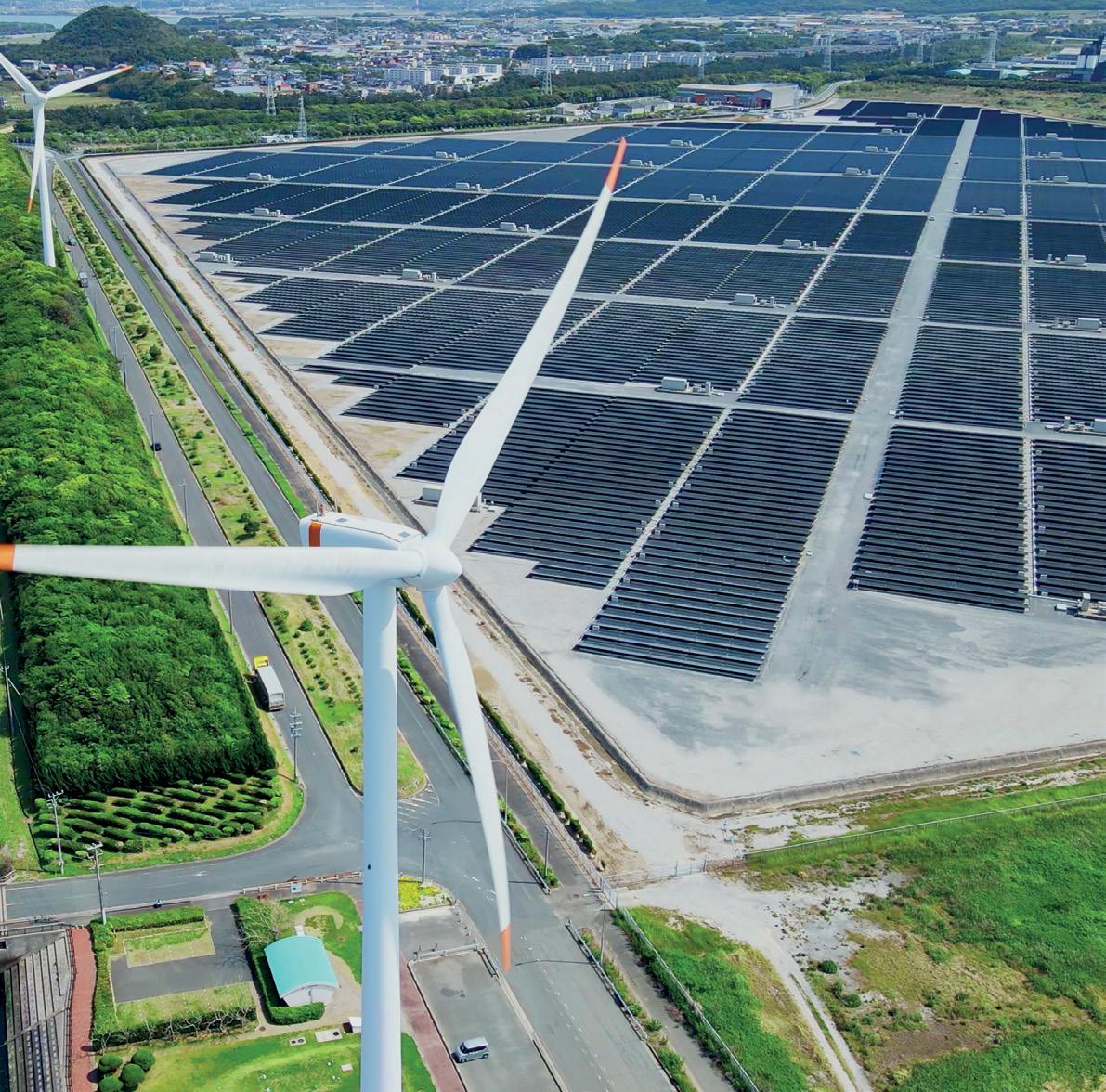
“We do not underestimate the scale of the challenge or the pace at which this transformation must occur, especially in light of the economic and supply chain headwinds impacting many sectors of our economy, including energy.”
The CEFC said it will provide further information on the investment approach for each of the three new investment priorities in due course.
Indigenous communities are partnering with climate change advisory firm Pollination to deliver one of Australia’s largest clean energy projects, producing green hydrogen products for domestic and export markets.
The East Kimberley Clean Energy Project will take advantage of the region’s abundant sunshine, fresh water and export-ready harbour to create Australia’s first 100 per cent renewable energy hydrogen and ammonia production hub.
The project is being created under a first-of-its-kind partnership in which the traditional owners of the land – MG Corporation and Balanggarra Aboriginal Corporation, will join the Kimberley Land Council and Pollination as equal shareholders of the project development process and the company created to oversee it, Aboriginal Clean Energy (ACE).
Project scoping has been completed and development will continue over the next 12 months. Pending the completion of feasibility and capital raising stages, construction could commence as early as late 2025 with first production by the end of 2028.
Stage one of the project involves building a greenfield 900MW solar farm – the largest in Australia – and a 50,000tpa hydrogen production facility – on MG Corporation freehold land near Kununurra, Western Australia. Electrolysis will convert fresh water from Lake Argyle into green hydrogen, which will be transported via a new 120km pipeline to the existing Port of Wyndham.
The hydro facility at Lake Argyle will supply baseload renewable energy to an ammonia production facility in Wyndham, producing approximately 250,000tpa of green ammonia. The result will be Australia’s first and only 100 per cent renewable green hydrogen and ammonia project.

Green ammonia produced by the facility will be used locally in agriculture and for export to key trading partners in Asia and Europe.
Stage one is designed to leverage the region’s existing assets including:
» The Port of Wyndham, which has an ideal location and is well suited for exports to Asia
» The existing Ord Hydro facility and electricity transmission network
» Road networks and airport facilities that link key sites to be used for production and distribution
Pollination Head of Projects, Rob Grant, said that this project represents a just, ambitious and achievable vision for Australia’s clean energy future.
“It leverages the natural advantages and existing energy and port infrastructure already in place in the East Kimberley region to create a major new clean energy export hub that will help Australia and our region decarbonise, grow new industries and ensure traditional owners and local residents are shareholders, not just stakeholders, in the benefits,” Mr Grant said.
“The main requirements for green hydrogen production are clean water, sunlight and renewable energy sources and all are abundantly available in this project,” Mr Grant said.
“Dozens of governments worldwide, many of them in our
neighbourhood, have already issued a hydrogen strategy –flagging how critical this resource is going to be as the world moves towards net zero.
“The Federal Government has placed green hydrogen at the heart of its plans to become a clean energy superpower in the future global economy and this is exactly the kind of project that will be critical in making good on that ambition.”
The project will be planned, created and managed by the ACE Partnership, the new company in which equal shares are owned by MG Corporation, Kimberley Land Council, Balanggarra Ventures and Pollination.
The partnership model allows an integrated development process for heritage, native title, environmental and engineering approvals using true co-design and co-decision making from the partnership’s shareholders.
The ACE Partnership said the model is a fairer and more just approach compared to how resource projects have traditionally been developed. It is also one that significantly reduces project development risk and shortens the project’s development schedule.
Balanggarra Aboriginal Corporation CEO, Cissy Gore-Birch, said the ACE partners bring differentiated but crucial individually lived experience and knowledge to this project.
“From cultural heritage, social engagement and remote land management to renewable energy and green hydrogen project and industry experience, the suite of skills required to effectively deliver this ambitious project on traditional lands in the East Kimberley exists only within this consortium,” Ms Gore-Birch said.
MG Corporation Executive Chair, Lawford Benning, said the partnership represented an important way forward for Traditional Owners.
“A focus on First Nations economic empowerment has led groups like ours to reject the historic passive engagement model of receiving royalties for agreeing to give up control of our lands,” Mr Benning said.
“This project gives us a chance to be active shareholders, understanding the risks and rewards, and making informed decisions about long-term strategic projects on our Country. Anything we do must be sustainable, intergenerational and connect culture and heritage.”
KLC CEO, Tyronne Gartsone, said the partnership represented an entirely new model for First Nations involvement in large infrastructure projects and the clean energy sector and could be replicated across Australia in order to help deliver on the nation’s climate change commitments.
“The recent Melbourne and Queensland University Net Zero Australia report shows that at least 45 per cent of the renewable energy we need to decarbonise our domestic and export energy supply will be located on land that is subject to native title,” Mr Gartsone said.
“We cannot have a just transition to net zero without First Nations ownership of the solution and projects that ensure we can get there.”
The Australian Energy Market Operator (AEMO) has published the Engineering Roadmap FY2024 Priority Actions Report, which outlines the actions AEMO plans to take to help prepare the National Electricity Market (NEM) for the growing renewable transition.

The AEMO said as Australia increasingly observes new renewable energy milestones, completing the necessary engineering work will be paramount to enable secure and reliable electricity supplies during periods when there are no fossil fuelled generators online.
This report seeks to continue the work from the Engineering Roadmap to 100% Renewables, by providing transparency on the specific activities the AEMO is progressing in 2023-24, while also providing an update on the extensive progress made in 2022-23 by AEMO and industry to increase preparedness.
AEMO Manager of Future Energy Systems, Chris Davies, said that readiness for 100 per cent instantaneous renewables is a critical enabler for being able to operate the power system regularly with high penetrations of renewables, in turn supporting the transition to a net zero energy system.
“The transition requires a concerted effort across industry, and this report summarises the major engineering and operational
The Bouldercombe 50MW/100MWh grid-scale battery has been officially switched on in Queensland.

The battery, nicknamed ‘Big Bessie’, is part of the Queensland Government’s Energy and Jobs Plan, and will take Central Queensland’s role in generating the state’s energy and supercharge local energy affordability.
The battery, located just outside of Rockhampton, will help revolutionise the way energy supply and demand can be managed in the region during peak times.
When fully operational at the end of 2023, the large-scale storage system will provide ancillary services to also support the stability and reliability of the transmission network that supplies power to more than five million Queenslanders.
Minister for Energy, Renewables and Hydrogen, Mick de Brenni, said that the energisation of the Bouldercombe Battery Project signals yet another step towards making the Queensland SuperGrid a reality for local communities and putting downward pressure on household energy bills.
readiness activities that AEMO intends to progress in this next financial year,” Mr Davies said.
The AEMO intends to make progress towards over 80 different actions throughout 2023-24, with this report spotlighting a subset of activities where AEMO is seeking to drive significant progress in the year ahead.
This includes activities where:
» AEMO believes significant uplift in effort is required to prepare for associated Roadmap preconditions
» Engagement with external stakeholders is crucial and not fully captured through other work programs
» Delayed progression may pose a risk to power system security in future
Based on these principles, the priority actions identified for 2023-24, cover four objectives:
1. Enabling high penetrations of distributed energy resources (DER)
2. Enabling new technologies to address system needs
3. Conducting future power system studies
4. Building operational readiness
“Batteries are fast and flexible, with the ability to ramp up and down instantaneously to support the stability of the power system and reduce wholesale price volatility,” Mr de Brenni said.
“This battery, along with our Cost-of-Living Rebates, show that the Queensland Government is committed to helping keep costs down for households.”
Genex CEO, James Harding said the energisation of the Bouldercombe Battery Project is a significant milestone for Genex, as it marks the start of commissioning of the company’s first large scale battery energy storage system and will play an integral role in diversifying the Genex portfolio of assets which includes solar, wind, pumped hydro and battery storage.
“Given the acceleration of the clean energy transition over the past 18 months, the successful connection of the project is timely, as it will store and supply up to 35,200MWh of power per annum and enable the further penetration of renewable energy in the state.”
Brighter Super has been supporting energy and electrical utility workers for over 40 years to reach their retirement dreams and is committed to doing this as much as possible face-to-face.
Brighter Super CEO, Kate Farrar, said while it's a busy administrative time of year, don’t forget to plan ahead to ensure you are getting the most out of superannuation.

“We have been listening to what our industry members want and need, and one of those things was not to lose our personalised approach as we grow. We really listened and today have more than 40 consultants on the ground, more than any other superannuation, ready to meet members and support them on their retirement journey.”
Brighter Super has seen thousands of members in the last year, and there are the three C’s that they recommend all employees should consider at this time of year.
1. Check – that your retirement is on track. Request a super health check with your super fund
2. Consolidate – find out if you’re paying fees on multiple accounts and discuss consolidation with your super fund
3. Contribute – Consider your budget and whether you are able to make additional contributions
A little planning now can go a long way to making 2024 a brighter financial year.
Brighter Super is a proud Queensland not-for-profit fund, and with 259,000 members and $29 billion funds under management, it is also one of Queensland’s largest non-government financial institutions.
With headquarters based in Queensland, we are the industry super fund that has been supporting energy workers for over 40 years. Now with greater scale, we manage the retirement savings for over 250,000 members, which means we are able to increase the personal service our members want, and keep their fees lower.
at www.brightersuper.com.au/about-us/governance before making any decision.

As the new financial year kicks off, it is time to ensure your current superannuation is supporting your future plans.
Registration is open for Engineers Australia’s flagship conference, Climate Smart Engineering 2023 (CSE23), to be held at the world-class sustainable Melbourne Convention and Exhibition Centre on 29-30 November 2023.
Now in its third year, the program for CSE23 includes some of the profession’s brightest and boldest minds as well as key leaders across government and industry offering diverse perspectives on climate mitigation and resilience, the clean energy transition and opportunities in the circular economy.

This is a conference for knowledge-sharing, networking and engaging debate on engineering-led climate solutions – reflecting the critical role the profession will play in driving the economy-wide transition to net zero. Speakers will demonstrate why it is important for sustainable practices and environmental considerations to be at the forefront of everything we do.
The conference will feature a full technical program supported by plenary sessions, networking opportunities and exhibitors that will challenge, confront and inspire attendees. The key themes that underpin this year’s conference program include adaptation and mitigation, resilience, social impact, business management, regeneration and systems thinking, energy transition, the circular economy, technology and innovation.
Join Engineers Australia for the must-attend sustainability conference of 2023.
29-30 November 2023
Melbourne Conference and Exhibition Centre
For program information and to register visit engineersaustralia.org.au/cse
Climate Smart Engineering Conference
29-30 November 2023 | Melbourne
Connecting engineering minds, ideas and opportunities, Climate Smart Engineering Conference (CSE23) will showcase the latest solutions to pave the way for net zero emissions in Australia.

Register now engineersaustralia.org.au/cse

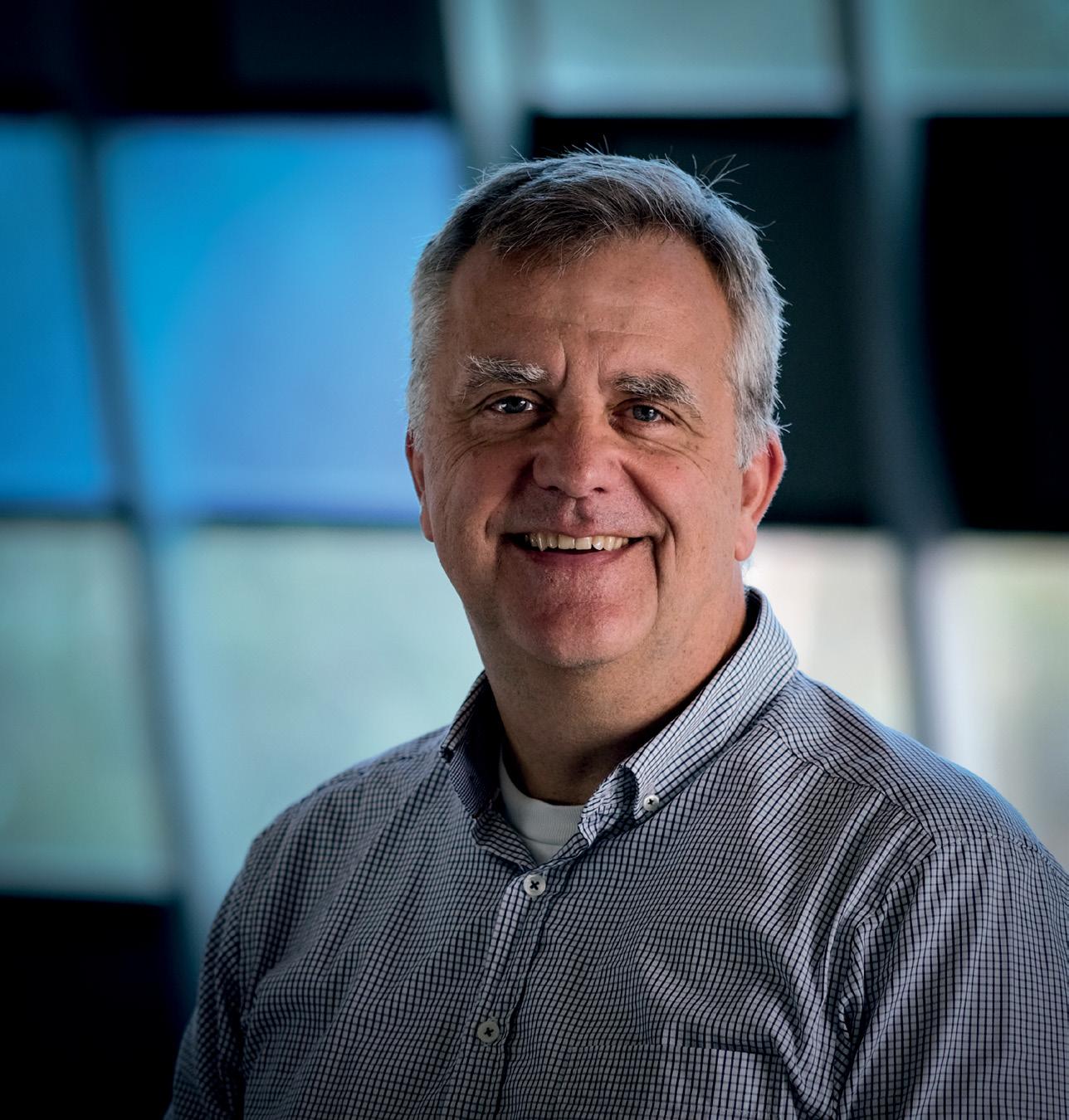
Taking on a director role in Australia’s national science agency is certainly not for the faint of heart – or a pessimist. The industry is experiencing rapid change and enduring pressures from not only political and environmental sectors, but also from everyday Australians who want more affordable, reliable and cleaner sources of energy. It would seem new Director of Energy, Dr Dietmar Tourbier, has his work cut out for him.
f destiny had played its cards slightly differently, Dr Dietmar Tourbier could have embarked on a career as an astronaut. With a Master’s Degree in aerospace engineering from the University of Stuttgart and a PhD with a focus on computational fluid dynamics from the University of Arizona under his belt, Dr Tourbier's first industry job was working on technology development for an aerospace company.
But ten hours spent in a vacuum chamber at NASA’s Johnson Space Centre testing a glove prototype revealed Dr Tourbier’s claustrophobia and cut short his ambitions for space exploration.
“I’m still fascinated with space,” Dr Tourbier said, speaking from his home in Victoria.
“I really appreciate the technology development we gained through space flight. But after that test – that time spent panicking in a small capsule – I knew I was never going to do it again.”
A loss for the aerospace sector was a gain for the energy industry. Dr Tourbier moved on to a highly successful 20-year career with General Electric (GE), starting with a role at their solid oxide fuel cell (SOFC) division in California, where he developed a passion for clean energy through fuel cell development.
When GE stopped working on fuel cells in 2007, Dr Tourbier remained with the company but returned to his home country of Germany – first in a leadership position with the global power electronics technology research group, and then as their European Research Leader.
It wasn’t until 2018, when GE started closing all their corporate research centres outside the US, that Dr Tourbier eventually moved to Australia with his family, and took up a position as Director of the Australian Solar Thermal Research Institute (ASTRI) – an elevenyear, $110 million international research collaboration led by CSIRO.
“My wife is originally from Arizona, but she had been living in Australia and we had been splitting our time going back and forth between Australia and Germany,” Dr Tourbier explained.
“When GE closed down their international centres, I took that as a sign that it was the right time to move again. My wife discovered this job advert from a place called CSIRO. I assumed that as I was German and it was the Australian national science agency, they would never hire me. But, to cut a long story short – they did!”
During his tenure as Director of ASTRI, Dr Tourbier brought together an impressive team of research organisations and engaged industry partners to incorporate solar thermal technologies developed by the institute. While there are not yet any solar thermal plants running in Australia, ASTRI’s research continues to bring the goal of efficient, affordable solar thermal much closer.
Dr Tourbier’s success in this initial role with CSIRO, along with the experience gained through two years as Deputy Director of the Energy Business Unit, meant that he was an obvious candidate when the Director of Energy position became vacant in 2022. His appointment to that role was formally announced in May 2023.
It’s an exciting, but enormously challenging time to step into the role as CSIRO’s Director of Energy. Australia’s energy sector is undergoing a radical transformation – not just in terms of electricity generation, but also across industry, transport and exports. New technologies, changing consumer preferences and ambitious emissions reduction targets are driving the transition at a rapid pace – and while that’s definitely a good news story, it’s also raising some challenges that need to be addressed.
As the national science agency, CSIRO is tasked with providing robust, actionable energy research to government, industry and other stakeholders, allowing them to target investments, implement policies, and adopt new technologies over the coming decades.
Steering Australia through the complexities of an energy transition to net zero emissions will require Dr Tourbier to draw on every bit of his deep industry knowledge, his networks of national and international stakeholders, and his passion for innovation and technology. However, he is keen to emphasise that CSIRO’s strength lies in its breadth of expertise and collaborative approach to research.
“At CSIRO we are working on solving Australia’s greatest challenges that we have identified,” Dr Tourbier said.
“We are addressing those across the whole organisation and taking a multidisciplinary approach. There are six focus areas, which include Health and Wellbeing, Future Industries, Food Security and Quality, Secure Australia and Region, and Resilient and Valuable Environments. I am responsible for the Sustainable Energy and Resources challenge.”
Within each challenge, there are a number of Missions: large-scale, impact focused scientific and collaborative research initiatives aimed at making significant breakthroughs with a tangible end goal.
“Missions are portfolios that have, by definition, a finite time to deliver impact,” Dr Tourbier explained.
“We have discovered that they help us work much more effectively across different business units. For Sustainable Energy and Resources, the first two Missions we have established are Hydrogen Industry and Towards Net Zero.”
CSIRO’s Hydrogen Industry Mission was established in 2021, with a focus on building commercially-viable Australian hydrogen energy. Towards Net Zero was established in 2022 with an initial investment of $90 million, with the goal of helping Australia’s regions and hardest-to-abate sectors halve their emissions by 2035.
There are currently two additional Missions in development that are of particular relevance to the energy sector and will be a major focus for Dr Tourbier over the coming months: Renewable Energy Powerhouse and Smart Energy.
“We have all the ingredients here in Australia for the critical energy minerals that are required to power the clean energy transition,” Dr Tourbier said.
“But at the moment we dig those up, ship them elsewhere, and then have to buy back the products. What we’d like to do with the Renewable Energy Powerhouse Mission is explore how we can move Australia further along the value chain. There’s an International Energy Agency (IEA) analysis that shows Australia can have the lowest cost clean energy of all OECD countries – we want to help achieve that.”
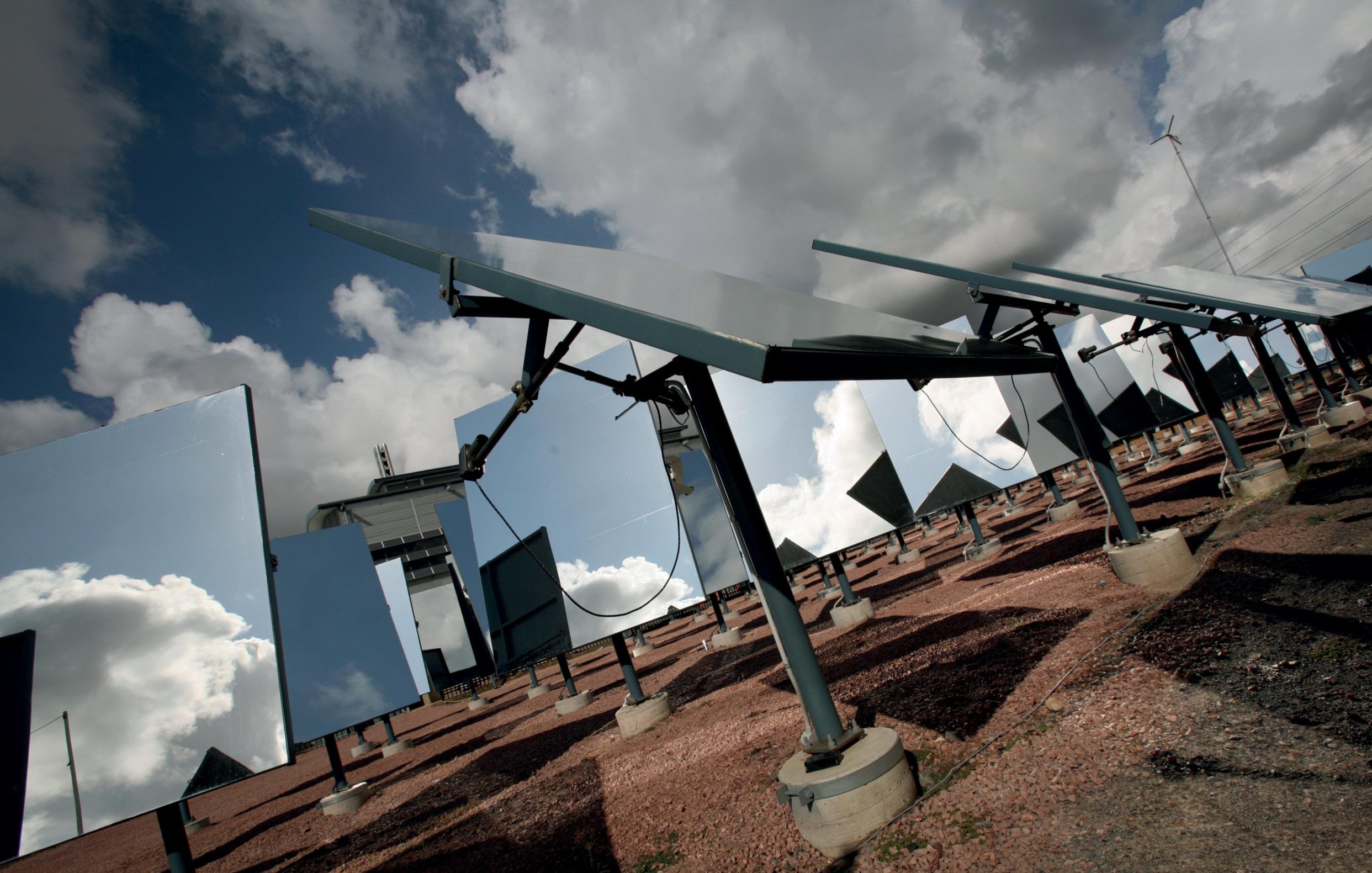
“Smart Energy is about how we design a system with far more connectivity between transport, heavy industry, communities and consumers. Where hydrogen, gas, water and electricity are more interlinked than they are today. We’re moving to a far more dynamic energy system, and working out how to operate it is a complex challenge.”
“We need our energy system to be clean,” Dr Tourbier said.
“But we also need it to be sustainable, reliable and affordable, and we need that to happen as quickly as possible. I am excited to play my part in that.”
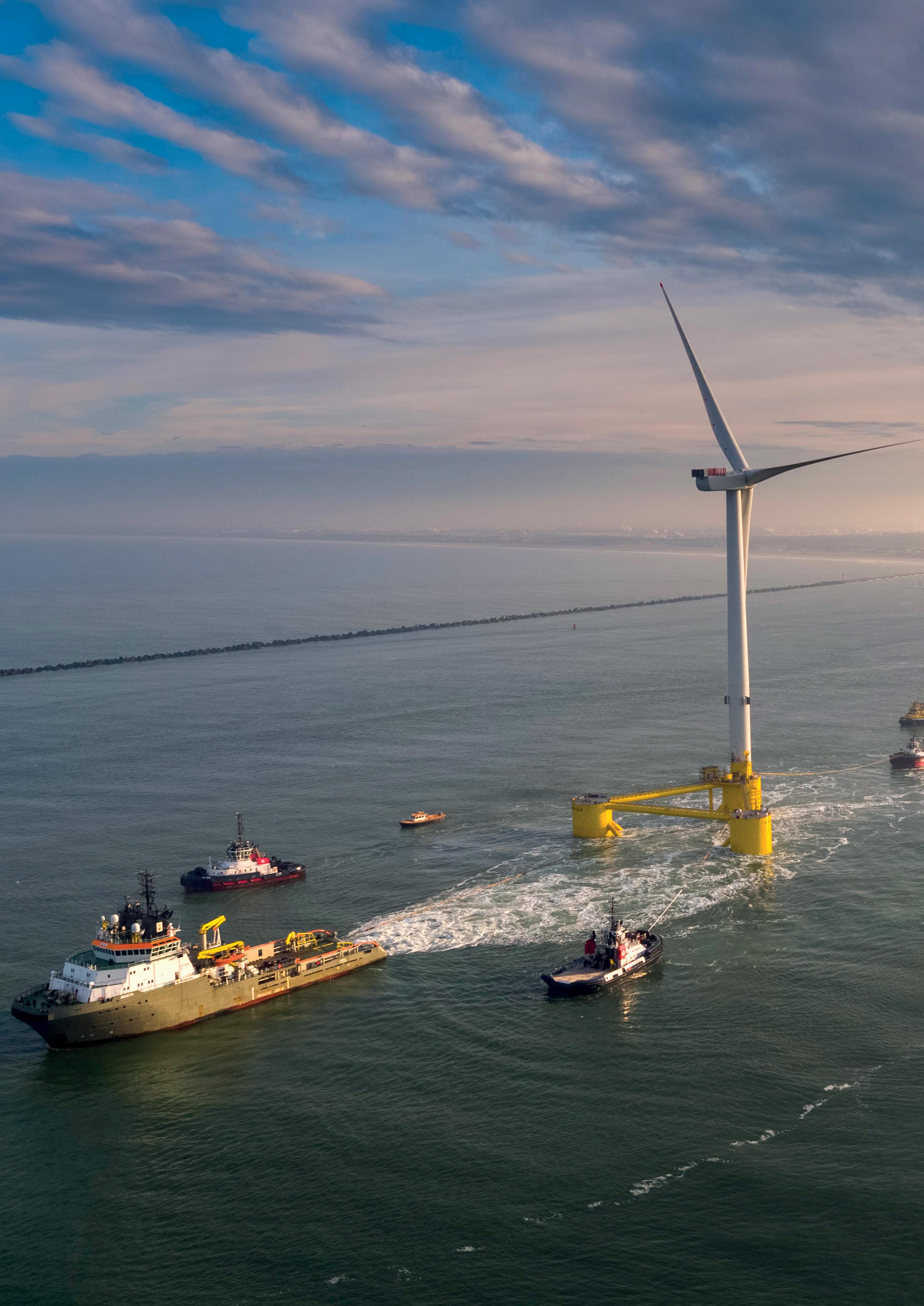
As Australia's transition to a sustainable and low-carbon energy future gains momentum, offshore wind continues to emerge as a crucial component of this transformation. Flotation Energy, a global offshore wind developer, is at the forefront of this movement and globally renowned for pioneering floating offshore wind and energy transition projects.

Our founders, Allan MacAskill and Lord Nicol Stephen, developed Kincardine, the world’s largest floating wind farm. The company is rapidly growing, with the focus on delivering more than 13GW of commercial scale fixed and floating offshore wind farms and has plans to expand into key markets.
In Australia, these include the 1.5GW Seadragon Offshore Wind Project off Gippsland and the 1.5GW Southwest, Perth and Wannaroo Arrays.
The opportunities for offshore wind in Australia are boundless.
The Gippsland region has a 50-year proud energy legacy. These skills are certainly transferable and Flotation Energy is committed to continuing this legacy for decades to come.
In fact, I myself have transitioned from the oil and gas sector. An Engineer by degree, I worked for 19 years in the Bass Strait oil and gas industry, gaining experience in facilities and pipeline engineering, risk management, safety and environmental management of offshore activities and commercial operations.
Working closely with the Gippsland community, I witnessed firsthand the impact and prosperity that the oil and gas industry brought to the region. As we started to plan for the ultimate decommissioning of the Bass Strait facilities and it became increasingly clear that the world needs to rapidly transition away from fossil fuels, I wondered what the future held for communities like these.
In offshore wind, I could see the future of the Bass Strait offshore energy industry; a chance for the capable local workforce to use their skills and for the region to transition from being known for fossil fuels to being known for large-scale renewable energy. Many of the Flotation Energy team have previous experience in offshore oil and gas and have made the transition smoothly into offshore wind, as I have.
Flotation Energy firmly believes that Australia's offshore wind industry has the potential to replicate the success of the UK offshore wind industry. However, to realise this potential, the Federal Government needs to establish a clear policy framework that includes generation targets and timelines.
Certainty in policy drives investment, innovation, job creation and economic growth. Victoria has taken a significant step by setting its own offshore wind policy at the state level, but a nationwide approach
is needed to unlock the industry's full competitive potential.
Clear federal generation targets will go a long way to providing the necessary confidence needed to drive investment.
Clear policy guidelines serve as a powerful catalyst for investment and commitments from Original Equipment Manufacturers (OEMs) and suppliers. Without a well-defined offshore wind policy, OEMs and suppliers are unlikely to invest in the Australian market.
The UK's commitment to achieving 50GW of offshore wind capacity by 2030 has attracted substantial investments, including commitments from OEMs and the development of a robust supply chain. Furthermore, government policies play a critical role in the success of the offshore wind industry in Australia and can make or break the fledgling offshore wind industry. It’s critical to learn the lessons of other markets and embrace the successes. The UK Sector Deal is one such example, which has led to significant cost reductions in new projects.
The UK sector deal includes investment of £250 million to develop the UK supply chain, helping to leverage £48 billion of investment and 27,000 jobs – including jobs from the oil and gas sector.
If Australia can look to the UK to learn the hard fought lessons, it is clear that smart policy, coordinated enabling infrastructure and working hand in hand with industry will deliver the renewable energy solutions needed to meet Australia’s commitment to reduce its emissions.
Promoting local content production is crucial for creating jobs and supporting local economies. However, it is essential to strike a balance to avoid unintended consequences.
In Taiwan for example, unplanned and unrealistic local content policies have driven up power prices. Carefully designed policies that encourage local content without hindering the industry's growth potential are what is needed to ensure growth of an industry.
There has been no major energy technology that has successfully been brought to market without support mechanisms to build that industry.
The offshore wind industry is no different. Certainty around power price support – such as a well-defined contract for difference mechanism or similar – is the single biggest requirement for a positive
Final Investment Decision (FID) for an offshore wind farm.
Capital contributions by governments to individual projects tend to be small compared to the significant capital costs of building these projects (billions) and aren't the key driver towards positive FID. Governments should channel their capital investment into supporting infrastructure including transmission and ports, which will enable the industry as a whole.
Again, the UK Sector Deal is a strong example of how to best unlock a new industry. Significant investment by the UK Government has led to a strong supply chain and a proliferation of new jobs.
Australia can harness these lessons to ensure it attracts investment and drives industry growth.
Flotation Energy's team has a track record of delivering offshore wind projects and has demonstrated its global experience and expertise. The Seadragon project off Gippsland will bring $6.5 billion of investment into the region.
This forms part of an estimated $40 billion of proposed energy projects in Gippsland that are already creating employment opportunities and will

ultimately lead to a construction boom and long-term operation and maintenance jobs.
Seadragon can be ready in five years and power up to one million homes. The project will create 100 jobs during the development phase, 800 to 1,000 jobs during construction, and 150 to 200 ongoing jobs over its 30-year operational life.
Flotation Energy is also working directly with the University of Melbourne to ensure the future workforce has the skills needed for the offshore wind industry.
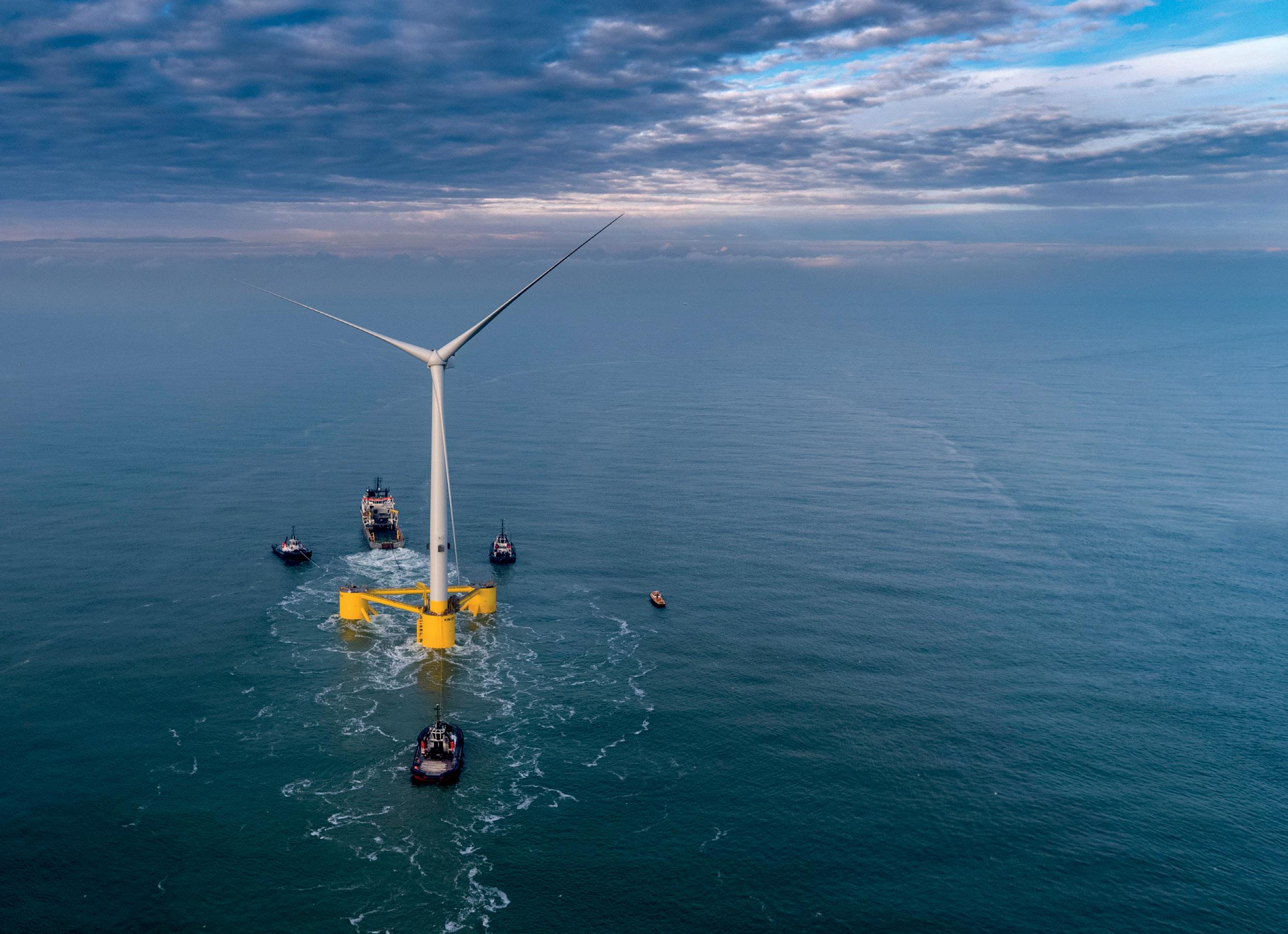
The Memorandum of Understanding with the University of Melbourne will help to deliver graduates ready to work in the new offshore wind industry, along with cutting-edge research specific to Australian conditions. This is a clear demonstration of the opportunities of the energy transition.
In our view, community engagement is what sets us apart from other proponents. Since 2019, we have been engaging with the local community and we have well-established relationships with key community stakeholders. Ensuring the community can be part of the transition, benefit from the transition and have agency over the developments in their communities is what drives our engagement.
Recognising the strength of Flotation Energy’s projects, in November 2022, Tokyo Electric Power Company (TEPCO) Renewable Power Inc acquired Flotation Energy, making its first equity investment into overseas offshore wind power.
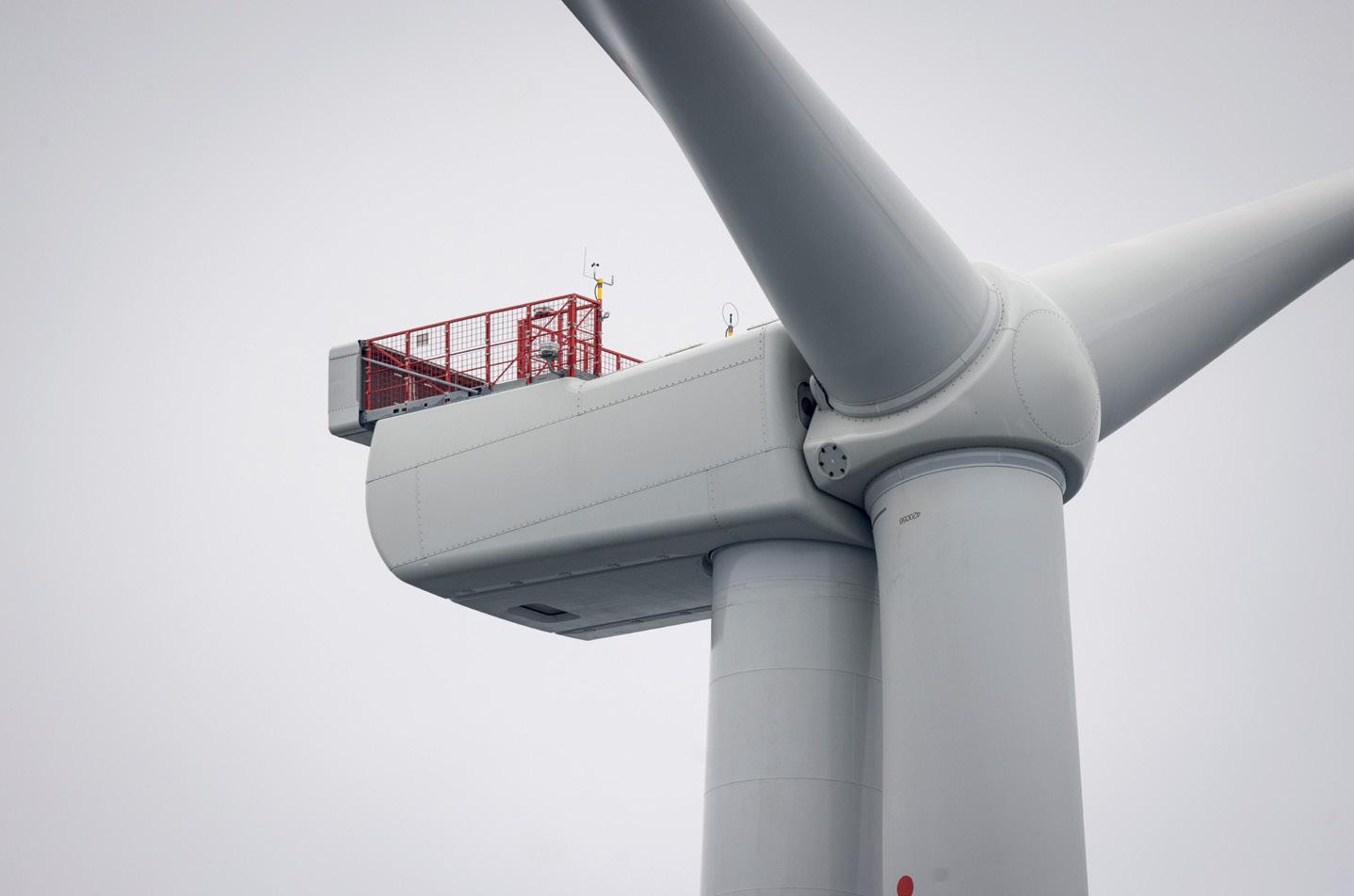
TEPCO is Japan’s largest electricity utility and one of the largest in the world. This partnership unlocks significant capital and expertise across all of Flotation Energy’s projects.
Australia has incredible potential to unlock a booming offshore wind industry. Flotation Energy has been working with the Gippsland community since 2019 and is deeply committed to delivering one of its first offshore wind projects. Smart policies, learning the hard fought lessons in other countries and strong industry incentives will ensure the government paves the way for a thriving offshore wind industry.
We
ith any project, starting with a strong foundation and understanding ground conditions is key. For wind farm construction this is where specialist geotechnical expertise is needed to guarantee long-term success.
At Stockyard Hill Wind Farm, a Goldwind Australia project in Victoria, diverse geological conditions required innovative solutions to be found for the safe construction of its 149 turbines.

While most of the turbine footings were constructed as gravity foundations, the other types – anchored and hybrid footings (a composite of gravity and anchored) –were strategically chosen based on the unique ground characteristics of each site.
Addressing the challenges posed by the diverse geological conditions, cutting-edge technology became instrumental. Experts from Tonkin + Taylor (T+T), a specialist engineering consultancy, utilised Plaxis 3D modelling techniques to simulate and analyse the gravity foundations. This allowed them to refine the design
Wand mitigate risks. Through several iterations, the team ensured that every unique set of ground conditions was meticulously addressed.
Heavy components on-site were carefully managed and transported. The detailed analysis of the pavement conditions, and crane lift studies, ensured the safe and efficient movement of materials and equipment, including the installation of a 170-tonne transformer at a substation.
Investigations and testing were essential to ensure the safety and integrity of the infrastructure. To facilitate this during the construction phase, Chadwick Geotechnics established an onsite NATA-accredited laboratory, with their specialist laboratory in Melbourne supervising and testing the initial investigation. Their services were pivotal during wind farm construction, drilling, and test pitting, as they performed proof rolling, plate load testing, and foundation inspections.
Another important aspect was understanding the soil composition and groundwater conditions, and their potential impacts on the project. T+T undertook detailed assessments to tackle the complex
geological and hydrogeological challenges. The hydrogeological studies brought attention to the presence of a high water table, prompting further enhancements to the foundation design.
The construction of four substations within the wind farm presented additional complexity, necessitating expert geotechnical input for ground investigations and foundation design.
Renewable energy and sustainability go hand-in-hand, and creative thinking was needed to meet the project’s sustainability goals. Pavement designs by T+T incorporated silt as a subgrade to minimise excavations, and external pavements were rehabilitated, where possible, to accommodate the wind farm material delivery and manage increased traffic.
At full capacity it can provide power for approximately 391,000 homes and is expected to prevent the emission of two million tonnes of carbon dioxide per year into the atmosphere annually. Stockyard Hill Wind Farm stands as an example of how geotechnical solutions can contribute to the success of renewable energy infrastructure today.
find ourselves at a critical juncture in Australia’s energy journey. The winds of change continue to propel our renewable energy progress, and harnessing wind power will be essential to meet a lofty but crucial goal of an 82 per cent renewable share of the National Electricity Market by 2030.
renewable energy growth is accelerating. Tonkin + Taylor’s geotechnical specialists are trusted advisors in the design and construction of renewable energy projects.




Wind energy generation is a vital part of Australia’s electricity system and the second largest contributor to the clean energy transition. However, end-of-life wind turbines can have a significant environmental impact. A new report from the Clean Energy Council (CEC) explores the reuse, repurposing and recycling of wind turbines, highlighting how industry and governments must work collaboratively to develop circular solutions.

Roughly 85 to 94 per cent of a wind turbine (by mass) is recyclable and can be recycled in Australia2. This recovery rate is well above the national average for commercial and industrial streams in 2018-2019 (57 per cent)3 and exceeds the National Waste Policy Action Plan target of 80 per cent average resource recovery rate from all waste streams by 20304. However, there is still potential for the wind industry to go further and avoid any disposal of waste.
One significant opportunity for further reducing waste in the industry is establishing an end-of-life pathway for turbine blades, which are mainly made of fibreglass and carbon fibre (composite materials). There are currently very limited commercial or feasible end-of-life options for composite materials.
It is estimated that by 2034, a total of 15,000 tonnes of blade composite waste will have been created in Australia due to decommissioned wind farms, and up to 4,000 tonnes in any given year. Without a clear pathway for the management of composite waste, there is a risk that these blades will be disposed of into landfill.
The CEC’s report provides an overview of environmentally and socially responsible approaches and practices for the decommissioning of wind farms. It highlights existing pathways for decommissioned wind turbines and sheds light on areas requiring improvement in recycling capabilities.
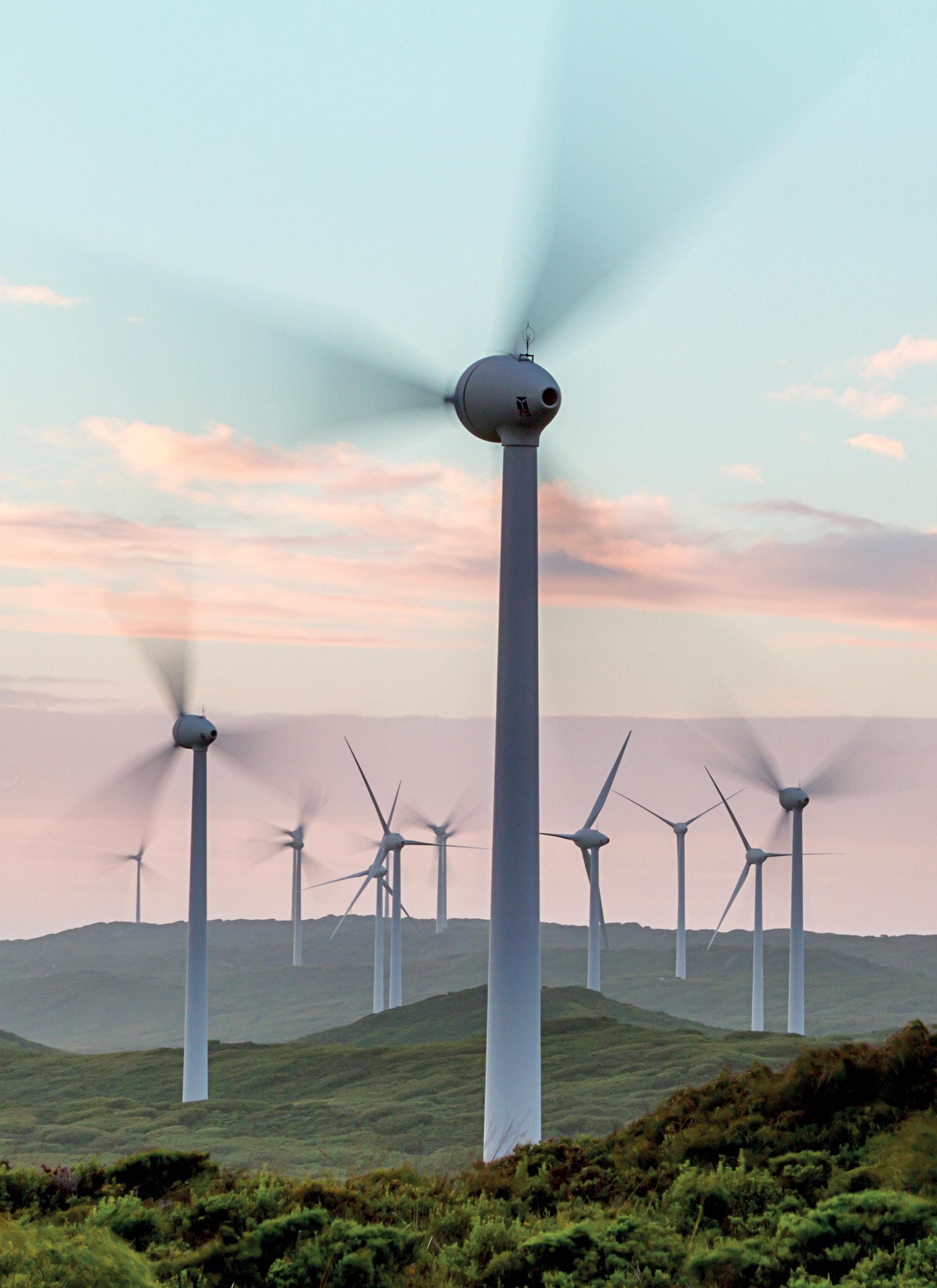
The first option for turbines that have reached their end of design life but remain in good condition is lifetime extension. If turbines are serviced and maintained according to performance standards and any identified issues are resolved, the design life of many wind farms can be extended with minimal investment.
The second option is a partial repowering, which typically involves an upgrade of the nacelle, rotor and blades while retaining the existing tower. This is designed to generate more energy from the wind farm, improve its availability and extend the operational life.
There are several critical considerations when determining whether a wind farm is a strong candidate for partial repowering. This includes assessing the integrity and capacity of the existing wind turbine foundations and towers, and assessing the impact additional years of operating would have on the electrical equipment.
A full repowering refers to the retrofitting of power plants on existing sites with new or refurbished technology. This can include building taller, more efficient wind turbines to increase productivity while utilising existing grid connection infrastructure. A full repowering is similar to constructing a new wind farm.
When a wind farm is decommissioned, owners must handle the components of a wind turbine. The CEC’s report utilises the waste hierarchy to explore a variety of options for wind turbine waste management.
While a significant portion of wind turbines can be recycled, the greatest barrier to zero waste turbines are the blades. These are made of epoxy and composite materials such as fibreglass or carbon fibre. Composite materials are currently difficult to recycle as the polymers used are ‘cross-linked’ in an irreversible process to obtain the desired material durability and strength while retaining a low weight.
The most common technology used to recycle blades is mechanical grinding, which utilises a grinding machine to process the composite materials into short fibres and ground matrix
(powder). Although this method is cost-effective and less energyintensive than other technologies, the end product is less valuable than the original composite material. The shredded material can be used as fillers or reinforcement in construction or manufacturing, such as panels for decking and construction, light poles, and possibly cement.
Without a clear and secure end market, this process is yet to be considered as a sustainable recycling option. However, there are some innovative solutions being explored.
Among those solutions is a recently developed chemical technology that can be applied to blades that are currently in use. The new process can chemically break down epoxy resin into virgin-grade materials. Renewable energy firm, Vestas, is now working to scale up the novel chemical disassembly process into a commercial solution.
Once fully developed, the solution will signal the beginning of a circular economy for all existing, and future epoxy-based turbine blades, possibly providing the opportunity to produce new turbine blades made from reused materials.
Another solution is electro-mechanical. High-voltage pulse fragmentation is a pilot-scale process that uses electricity to separate fibres from the composite matrices. Recovered fibres are short, but cleaner and longer than those generated from the mechanical process.
The low volume of composite wind blade waste has made it difficult to develop a recycling business built purely off wind blade waste streams. However, wind turbine manufacturers are starting to develop new blades that can be recycled, as part of their commitment to zero waste turbines by 2040.
For example, Siemens Gamesa has created the RecyclableBlade, the world’s first recyclable offshore wind turbine blades ready for commercial use. The recyclable blades use new types of resin that can be separated from the other components of the blade (fibreglass, plastic, wood and metals) through a chemical process, allowing the materials to be reused for new applications.
Reusing turbines or turbine parts is also an effective way to support zero waste in the wind generation industry. Pre-owned turbines and parts can provide lower-cost systems for smaller projects and developing markets. One potential market for pre-owned wind turbines in Australia is the mining sector, which is turning to renewable energy behind-the-metre and for off-grid applications in order to decarbonise its operations.
Another option is repurposing, which involves using the original engineered structure and properties for a new, different purpose and involves less processing than recycling.
Wind turbine blades can be repurposed for several, alternative functions. For example, in Europe, blades have been transformed into bus stops, playground equipment and public seats.
The Re-Wind Network, a research partnership comprising Irish and American universities, has developed a catalogue that presents designs and details of different structures and products made from repurposed wind turbine blades, including bridges, poles, sound barriers, roofs and farming equipment made from repurposed wind turbine blades.
While this repurposing avoids the need for using new materials to build those structures, the current options for blades are not easily scaled to commercial production and are not very sustainable.
The main barriers to repurposing include:
» Perceived lower quality of used materials
» Unknown residual structural properties
» Lack of end markets for the materials
» Unfamiliarity with sourcing and using recycled products
» Unpredictable material availability
» Uncertainty as to whether repurposing is truly better environmentally
Cement co-processing is one method for recycling wind turbine blades and other composite waste. This process is categorised as energy recovery as the polymer matrix is burned as fuel.
Using fibreglass blades as energy recovery reduces the carbon footprint of cement production by up to 16 per cent. Currently used by wind farms in Germany, the process is only available for fibreglass. While it is a scalable, simple and cost-effective solution, the process is very energy-intensive.
There are several other issues with this process. First and foremost is that recovery is low in the waste hierarchy. Other issues include the energy intensity required and the original structure of the blades is lost.
According to the CEC, instances of blades being disposed of via landfill in Australia have been minimal and mainly due to replacement of faulty or damaged blades from operating wind farms. However, as the number of wind farms requiring decommission increases, it becomes increasingly important to establish suitable recycling and recovery pathways for composite materials. There are potential solutions, such as using recycled composite material for construction or manufacturing, but greater focus and action is required by both the public and private sectors.
The CEC report makes four key recommendations for the wind industry, government and other composite-using industries:

» Support research and development
» Establish pathways and set targets
» Support recycling supply chains
» Share knowledge
Whether it's solar, wind or batteries, these critical clean energy technologies are composed of materials that wear down over time. Moving forward sustainably must involve a consideration of what happens to materials at the end-of-life stage.
From a distance, it might look like an aerial performance, but the work being carried out by a helicopter above the MacIntyre Wind Precinct is more than just a visual spectacle – it signifies the final stages of an important transmission connection project in south-west Queensland.

About 60km west of Warwick, the MacIntyre Wind Precinct is a mega wind farm being developed by ACCIONA Energia. At completion, it will have a generation capacity of close to 1,000MW of electricity and the potential to power up to 700,000 homes.
Powerlink Queensland has been engaged to ensure this renewable development is connected to the grid and its clean energy is accessible to Queenslanders and the wider National Electricity Market. The transmission construction works include 65km of 330kV transmission line, consisting of 166 structures and two new switching stations.
Transmission connection construction works kicked off in May 2022 and with more than 150 of the high voltage transmission structures already built, the stringing of transmission conductors and optical ground wire (OPGW) line is well underway.
Every year, more transmission lines are being constructed to facilitate the renewable energy transformation and help Queensland reach its renewable energy targets. Many of these lines are being planned in remote, less dense and geographically challenging terrain.

At the same time, the completion period for renewable energy projects is getting shorter which means it’s essential for transmission network service providers to employ the latest
advances in technology and construction approaches to deliver projects as safely, quickly and economically as possible.

Powerlink Project Director, Jahanzeb Rahman, said helicopters performing transmission line stringing is becoming more common across the industry particularly because it reduces community, landholder and environmental impacts, as well as construction timeframes.
“In the past this type of work had been carried out with heavy duty plant and equipment that had a significant impact on the environment as well as lots of manual handling and associated risk,” Mr Rahman said.
“On average a helicopter team can prepare and string up to 25 towers in a couple of days which helps to reduce the overall construction related impacts on the environment and landholders. It’s also considerably faster than on-the-ground methods, so what used to take weeks now only takes days.
“Every aspect of aerial stringing is meticulously planned by Powerlink and its contractors to ensure safe outcomes are achieved, with strict operational protocols in place such as installation of hurdles, traffic management, exclusion zones and on the ground spotters.”
The technique to string the transmission line involves using the helicopter to pull a steel cable, known as ‘draw wire’, from a brake winch on the ground. The helicopter pilot guides the draw wire onto a pulley attached to the arms of the tower. Once this has been completed, the draw wire is attached to the transmission line conductor (cable), and a winch is used to pull the conductor off conductor drums and onto the towers.
The MacIntyre Wind Precinct transmission connection project involves 65km of transmission line, 166 structures (consisting of both towers and poles) and by the end of their activity the helicopters will have facilitated the installation of 1,245km of conductor and 130km of OPGW – which provides vital communication functions and protects the infrastructure from lightning strikes.

John Caldwell, Managing Director and Chief Pilot at Leading Edge Helicopters, has dedicated his career to this industry with over 5,500 hours of power line operations across the country and has been working on Powerlink projects since 2006.
For Mr Caldwell, the number one aspect of the works is safety with a lot of time spent at the front end of the job to plan works effectively with ground crew that operate the brake/winch sites and aerial crews on towers.
During the course of its program of work at MacIntyre, the helicopter will hang more than 33,810 insulators on tower cross arms, fly 18 conductor pull missions using draw wire (11x10km sections and 7x400m sections) and complete 45 direct OPGW pulls over the course of nearly 200 hours of flying.
So skilled are these pilots and so highly specialised is their training, that only a handful of people are capable of carrying out this work in Australia.
“They’re in high demand and tend to work all year round all over the country which can pose challenges in terms of project logistics and timing,” Mr Rahman said.
“This means we are constantly scanning the horizon for new technology and ways of work to add to our capability and streamline construction, maintenance and other work we need to do on our network across Queensland.
“We are currently investigating the potential for drone transmission line stringing on other projects in our portfolio and looking to incorporate this into our construction activity elsewhere.”
Meanwhile helicopter stringing will continue at MacIntyre Wind Precinct where it is expected to complete stringing and other transmission line work by August 2023.
Powerlink’s construction work is expected to be completed by late 2023 with the wind precinct planned to start generating in stages from late 2024 onwards.
In an industry in a constant state of flux, and with environmentally-conscious decisions at the forefront of energy conversations, it’s becoming increasingly important to consider sustainable options – and reusing, repowering or upgrading parts to extend equipment service life is a clear way to do this.
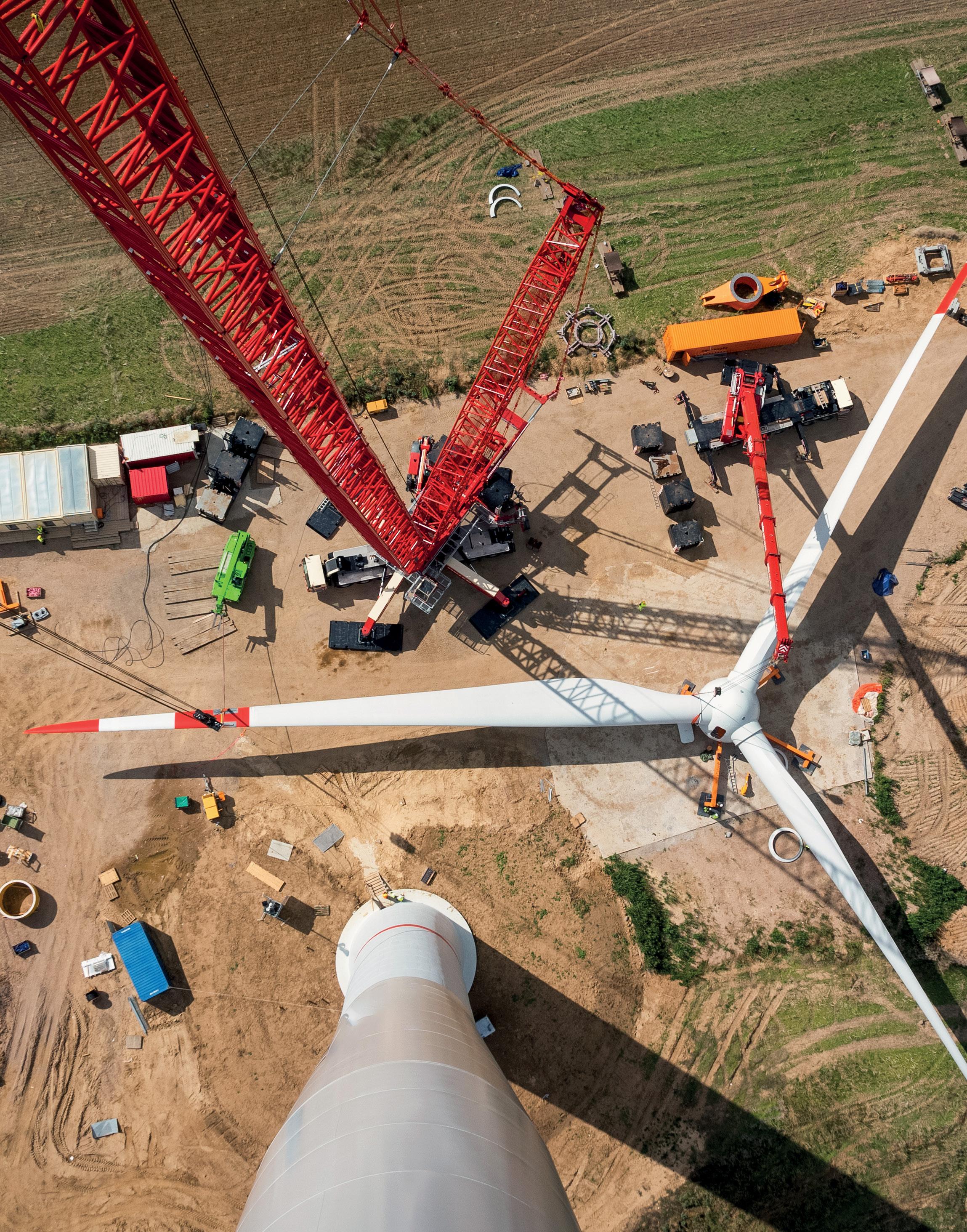
Managing wind turbines is no easy feat. From protecting workers from the dangers of wind turbine brake dust, to protecting surrounding communities from yaw noise and managing the general ageing of infrastructure and parts, it requires expertise and experience.

In its 2023 report, Winding Up: Decommissioning, Recycling and Waste Management of Australian Wind Turbines, the Clean Energy Council discussed the importance of upgrading wind turbine parts to support a longer usage lifetime.
“Reusing turbines or turbine parts, considered to be the option with the highest value for decommissioned wind turbines, is an effective and feasible way of obtaining a second life cycle,” the report said.
With over 599 turbines in Australia over 15 years old, the CEC said it was more important than ever for wind turbine owners to consider making more sustainable end-of-life cycle choices.
Getting the most from wind farms must include inspections and maintenance to ensure operation beyond the design life. Five major components that are regularly assessed include: blades, blade bearings, hubs, nacelles and towers. Structural components – tower, yaw systems, bed plates, main shafts and pitch systems – also have regular, necessary inspections to ensure safe and efficient operation.
The CEC report stated that a major issue in Australian wind farms is the limited number of wind turbines in operation that are compatible with refurbishments and repowering components. This is due to the low level of domestic access to necessary replacement parts.
With partial repower, drivetrain repower and component refurbishment supporting the potential lifetime extension of parts by 20 years or more, replacing and upgrading ageing parts should be a pivotal part of wind farm’s sustainability and financial practices.
Regal Rexnord, an international supplier of essential products that ensure smooth systems in mission-critical applications, includes a large portfolio of power transmission products. This includes yaw brakes, rotor brakes, high speed shaft couplings, clutches and brakes to service
the Australian wind energy market.
Regal Rexnord finalised the acquisition of wind turbine brake manufacturer and service partner Altra Motion in March 2023.
Altra Motion Australia Managing Director, Junior Eltagonde, said the companies have an exciting future ahead.
“From a strategy point of view, Regal Rexnord has really left us to continue on our growth initiatives and ensure that we keep supporting and looking after our customers,” Mr Eltagonde said.
“Down the line, there’s obviously some synergies that we can work on with our sister companies; however, particularly for us, we're very much business as usual and Regal Rexnord has really given us the autonomy to continue doing what we do best.”
Mr Eltagonde said that Altra Motion Australia may have a new owner, but it was the same Altra Motion that has supported the Australian energy industry with reliable power transmission and renewable energy solutions and service for decades.
“We are proud of this achievement and acknowledge this will continue as Regal Rexnord and Altra Motion collaborate and deliver their like minded people, ideas, and capabilities,” Mr Eltagonde said.
Regal Rexnord Australia is continuing to uphold Altra Motion’s three decades of experience in wind turbine braking systems and offers solutions to meet the needs of the entire wind turbine life cycle – with an emphasis on upgrading existing projects and equipment.
Working in close partnership with original equipment manufacturers (OEMs), Regal Rexnord will ensure it’s ‘business as usual’, developing products, components and assemblies to suit designs and specific requirements from the initial prototype phase.
Regal Rexnord Australia has multiple facilities across the country, including Sydney, Melbourne, Mackay, Newcastle and Perth. The service centres in Sydney, Perth and Queensland also serve as certified rebuild centres for Svendborg, Marland, Stromag, Ameridrives, Stieber & Industrial clutch products.
Fully staffed with local technicians, Regal Rexnord Australia provides fast-response onsite service, installation and commissioning support including a 24/7 breakdown callout service. With correct adjustments to OEM specifications and qualified and experienced OEM technicians, Regal Rexnord Australia provides unmatched power automation support.
For more information about Regal Rexnord Australia and their genuine spare parts and service capabilities, head to www.altramotionaustralia.com
There’s something new taking shape on Australia’s coastlines. Wind power has been used in Australia for decades, but now in 2023 – supported with federal offshore electricity acts and regulations – offshore wind power is set to blow fossil fuels out of the water. Supporting this industry growth is the latest declaration of the Hunter region as the nation’s second offshore wind zone. Here, Energy Magazine looks at the upcoming offshore wind projects in development or under proposal across the country.
Midwest
Size: 3,000MW
Operational: 2028
Technology: Fixed
Status: Announced
Myalup
Size: 1,900MW
Operational: 2026
Status: Under feasibility
Bunbury
Size: 2,000MW
Operational: 2026
Status: Under feasibility
Leeuwin
Size: 3,000MW
Operational: 2028
Technology: Fixed
Status: Early concept/ planning
ind farms are currently the second largest contributor to Australia’s clean energy transition after rooftop and large-scale solar combined, accounting for almost 37 per cent of renewable power generation in 2022.
There are currently 36 wind farms operating on mainland Australia and around 25 offshore projects at various stages of development. The new offshore projects underway feature a mix of fixed and floating platform designs.
Fixed (or fixed-bottom) platforms are closer to their land equivalents. Fixed platforms that are connected to the sea bed, can have four different foundations depending on the sea bed ground type and depth of underwater placement.
The four different foundations are:
Monopile
» Maximum depth of 30m
» Precast concrete foundation
WGravity
» Suitable for 25m depth
» Made of steel and driven into seabeds
Tripod
» For deeper waters around 35m
» Welded foundations with steel piles
Jackets
» For deeper water >40m
» Steel welded beams and often weighs more than 500t
The International Renewable Energy Agency said that floating platforms create three unique opportunities compared to fixed designs; access to deep-water sites, easy turbine set up and a less invasive installation on the ocean seabed.
Floating offshore platforms have three current varieties in design:
Spar buoy
» Ballasted cylinder
» Taut spread mooring lines with drag or suction anchors
» Designed for deeper waters >100m
Semi-submersible
» Large columns, connected by submerged pontoons
» Hydrostatic stability
» Positioned by taut spread mooring lines and drag anchors
Tension leg platform
» Highly buoyant, low mass
» Central column that is connected with three arms and tensioned tendons
» Foundation is secured to piled anchors
» Designed for ocean depths around 50-60m
Our map below is certainly not inclusive of all projects underway, or comprehensive regarding their details, as some projects have not announced the technology they plan to use but it’s clear the nation is understanding the value of utilising our offshore wind resources. Australia’s offshore industry, while in the early stages compared to its global counterparts, is, no doubt, going to significantly impact our net zero targets.
Hunter-Central Coast
Size: 1,650MW
Operational: 2030
Status: Intends to apply for feasibility licence
Newcastle Size: Up To 3,000MW
Eden Size: 2,000MW
Operational: 2032
Technology: Floating Status: Announced
Southern Winds
Size: 1,200MW
Operational: 2030
Technology: Fixed
Status: Undergoing site selection
Blue Marlin Size: 2,000MW
Operational: 2028
Technology: Fixed Status: Early concept/ planning
Greater Gippsland Size: 2,085MW
Operational: 2030
Technology: Fixed
Status: EIS/ESS preparations
Technology: Floating
Status: Proposed
Eastern Rise
Size: 1,725MW
Technology: Floating Status: Undergoing public consultations
Wollongong
Size: 1,600MW
Operational: 2030
Status: Early concept/ planning
 By Dr Glen Currie, Program Impact Manager –Energy System, Climateworks Centre
By Dr Glen Currie, Program Impact Manager –Energy System, Climateworks Centre
Why is building energy efficient infrastructure important? Due to physical infrastructure lasting 50-100 years, building it to be energy efficient will continue to pay us back for a very long time. This is because ‘negawatts’ – or the watts saved through energy conservation or energy-efficient choices – in buildings, transport and industry are the most cost-effective way to reach zero emissions.

Climate change is exposing Australia to more extreme weather. This means the impacts of climate change are increasingly being felt by businesses and consumers. But it is possible to make Australia’s homes, buildings, industries and transport systems more resilient and energy efficient – at a relatively low cost.
Climateworks Centre recommends energy efficiency be improved across the economy as part of Australia’s energy transition.
Our modelling shows energy efficiency in all its forms is not only the cheapest way to reduce emissions, but is also an economic opportunity that creates savings for energy consumers and the energy industry.
Climateworks’ 1.5°C-aligned scenario shows energy efficiency savings of around 280PJ of electricity and gas from buildings, and around 130PJ in industry. Energy efficiency measures are a no regrets solution – they are cost-effective.

What can the industry and transport sector gain from improved energy performance?
The 2023 Pathways to Industrial Decarbonisation report, prepared by Climateworks with CSIRO, shows a further 250 PJ/year can be saved in Australia by improving the efficiency of industrial and manufacturing processes and technologies.
For example, the report shows that increased recycling of minerals such as steel, electrification of mining and processing, as well as biodiesel trucks, would see emissions fall soon.
This will require significant investment. By 2030, up to $2.9 billion could be required for technology investments to achieve this emission reduction.
Additionally, increased electrification under the 1.5°C scenario outlined in the report would require a rapid scaling up of renewable energy generation and a doubling of total current electricity generation by 2050.
In the transport sector, gains can also be made from energy efficiency.
Transport that relies on fossil fuels and the internal combustion engines has a 30 per cent efficiency, whereas the roundtrip energy efficiency for electric vehicles is 80 per cent.
The opportunity for efficiency means we can provide transport services with electric motors and reduce oil imports to Australia, and also reduce the energy required for that transport.
While the opportunities for energy efficiency in industry and transport are huge, it is in the building sector where there is mature technology that can be deployed immediately.
Australia’s eleven million homes are responsible for over ten per cent of its total emissions and more than 25 per cent of electricity consumption.
Energy efficiency savings shown in Climateworks’ 1.5°C pathway represent a 39 per cent decrease in national building’s energy consumption by 2030.
It is important to improve the energy performance of existing and new homes.
In 2022, the American Council for an Energy-Efficient Economy (ACEEE) released an international energy efficiency scorecard, ranking 25 of the world’s top energy-consuming countries on their energy efficiency and carbon reduction policies and performance.
Australia placed 18th.
The Federal Government is now taking action, developing its National Energy Performance Strategy (NEPS). The NEPS could create clear signals to the market and communities, showing how energy performance improvements can contribute to the broader energy transformation.
The ACEEE report card shows how much Australia can learn from others with regards to improving performance across the economy.
Australia could set national energy efficiency targets –similar to those set by the European Union – using existing structures to deliver the strategy across Federal, State and Territory Governments.
Australia still has the chance to set out a process for the urgent development of 2030 and 2050 sectoral performance metrics and/ or targets for residential buildings, commercial buildings, industry and transport.


These would link to existing initiatives, legislation and governance structures such as the recently-legislated Annual Climate Change Statement to Parliament
Performance measures on technology uptake in buildings could be included – and could similarly apply to transport and industry.
Data
As noted, mature energy efficiency options for buildings are already commercially available. This makes the building sector a good place for governments to begin giving clear direction to the market.
Governments could start by developing a comprehensive policy package for improving energy performance in the sector. Such a package would include mechanisms to incentivise the energyefficient and zero-carbon renovation of existing buildings. Australia could institute appropriate energy efficiency targets and governance, and design national legislation aiming to normalise zero-carbon and climate-resilient buildings by 2030.
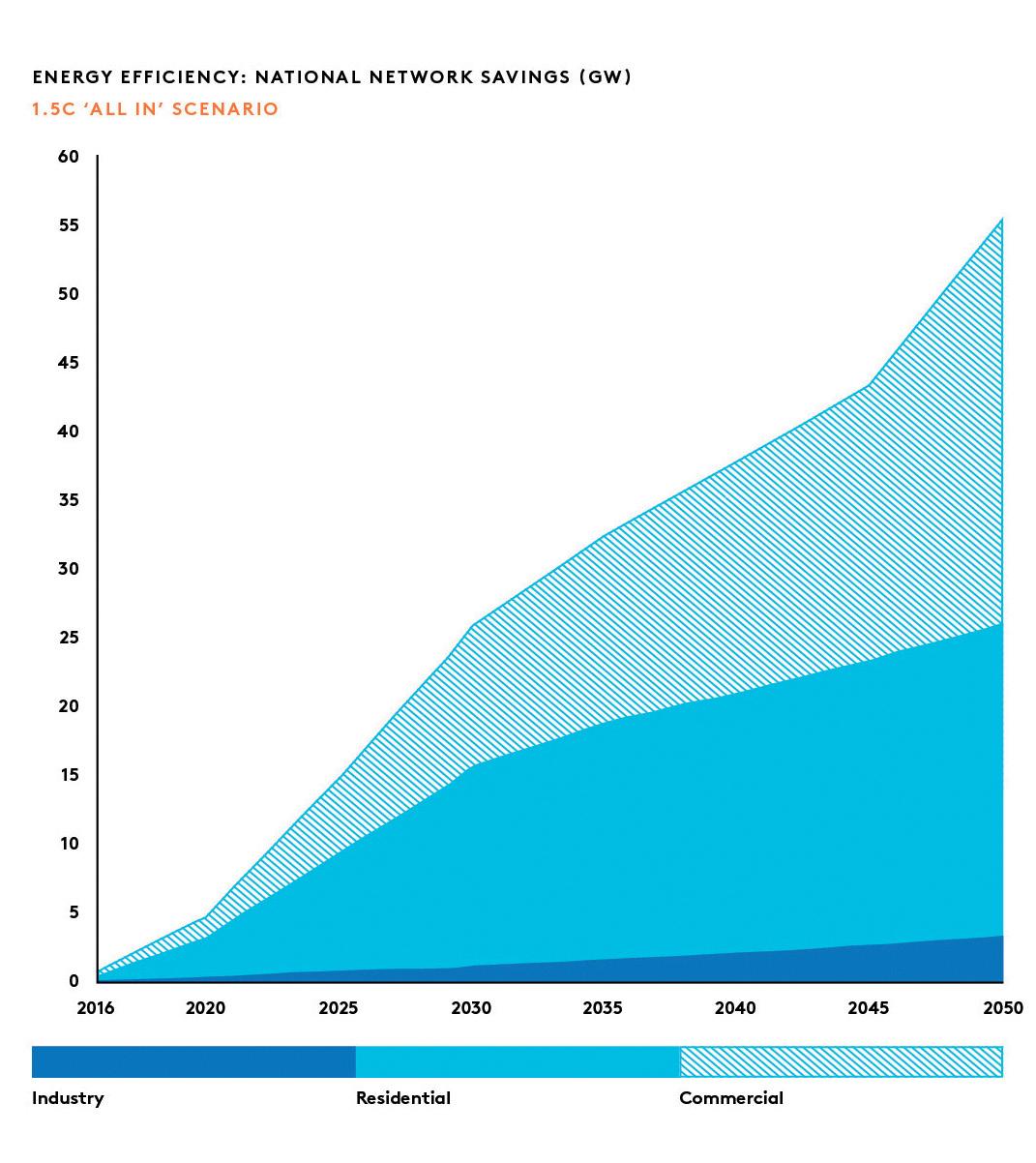
The recent agreement by the Energy and Climate Change Ministerial Council to update the Trajectory for Low Energy Buildings by the end of 2024 will help create momentum towards this goal. This includes updating and introducing new regulations for existing buildings.
People in low income households are particularly vulnerable to the adverse effects of poorly built homes, with recent research by the Australian Council for Social Services confirming that many in these households have difficulty keeping their homes warm in winter and cool in summer. These households will need support to improve the energy efficiency of their houses.
Assistance for these households could include government support for upgrading and building highly efficient social housing and improving low-income housing. This could kickstart energy efficiency supply chains in Australia.
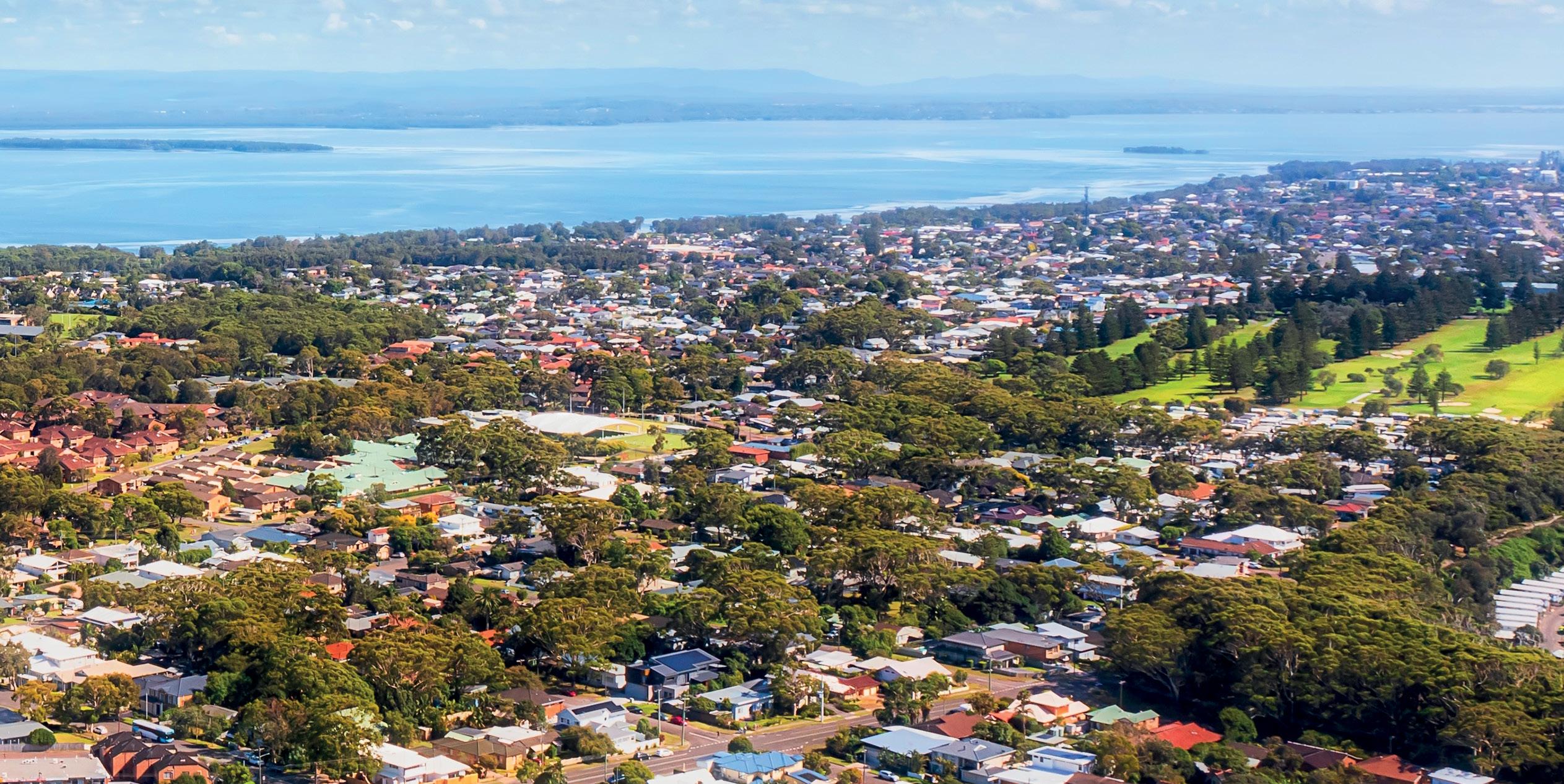
An energy efficiency upgrade program could then be rolled out nationally via mandatory energy assessments for rental homes. Such a program would include training assessors, publishing the collected data and making it accessible for research purposes, and a national roll-out of mandatory energy efficiency disclosure for rental properties. This would generate jobs wherever there are buildings.
These regulations could include minimum standards for rental homes by 2025. The Federal Government can collaborate with State and Territory Governments to help them implement such standards.
As we’ve seen, energy efficiency is an essential component of Australia’s response to climate change. There is a clear role for all levels of government in improving Australia’s energy performance, given its multiple benefits to business and wider society.
Moving forward, the Federal Government has the opportunity to design the NEPS to support Australia’s climate policy priorities, emissions reductions targets, and long-term goal of net zero emissions in line with the Paris Agreement. This is especially urgent, now more than ever, given the window to keep global warming within 1.5 degrees is still open, but narrowing.
The energy transition is happening, and it is happening fast. Yet challenges remain as we race at unprecedented speed to deliver our targets. A changing energy generation mix, ongoing decentralisation of the grid, and shifting consumption patterns, demand a coordinated approach from utility companies, energy infrastructure asset owners, users and partners.
Transmission and distribution companies are planning once in a lifetime builds to connect >40GW of new generating capacity across the National Energy Market in the next decade. At the same time, distribution providers are responding to growing maximum demand, reverse power flows created by rooftop solar and increasing levels of electrification across networks.
Through all this, the test facing organisations is exploring how to identify and bring the right partners and talent together to drive a successful transition.
The skills required to lead the transition – including engineers, electricians and project managers – have never been in higher demand. Organisations that can train and retain key talent and manage a coordinated multifaceted workforce will be sought after.
“Resources and innovation will make or break the transition,” Ventia Executive General Manager for Energy Networks and Renewables, Agathe Gross, said.
“We need to develop, plan and manage critical resources, like engineers, to design efficient connections to the grid for renewable assets.
“Linespeople and electricians are needed to build and augment distribution and transmission networks to facilitate connections and technicians to maintain operating assets.
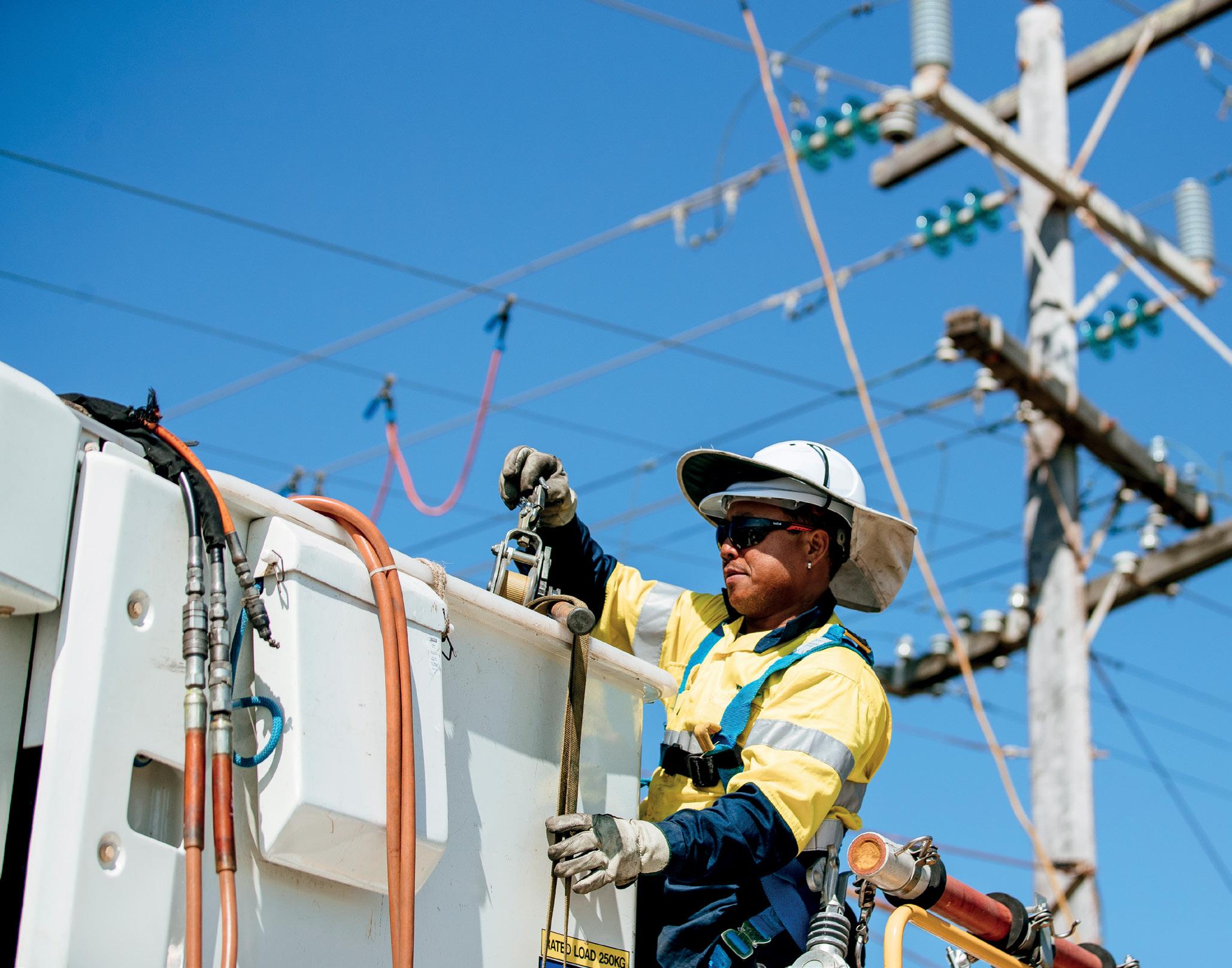
“It is estimated that the workforce will need to almost triple to meet the pipeline of work, and that is just for renewables.
“Innovation will also be a strategic enabler to deliver the work in an effective manner.”
For more than 60 years, Ventia has been a trusted partner to some of Australia and New Zealand's largest energy providers, users and asset owners. Ventia partners with utility infrastructure owners to drive operating efficiency, safety, and reliability, as well as assuring the ongoing value of energy assets.
“We’ve developed extensive capabilities and, to respond to their ambitious plans, we aim to grow in partnership with our clients,” Ms Gross said.
“This includes everything from design and construction of substations, design and construction on underground and overhead transmission and distribution networks, through to extensive operations and maintenance expertise.
“Our operations and maintenance skills are being successfully applied across wind and solar generation assets and this is something we’re keen to grow.
“We’re not just about field related offerings, we provide services 24 hours a day and seven days a week to our clients where we supervise, monitor and manage a broad range of assets leveraging our state-of-the-art Ventia Operations Centre.”
The trusted partnership between Ventia and clients also creates an environment to tackle complex challenges together.
“For example, Transpower in New Zealand will require a significant increase in their workforce over the next five or more years, to support their national grid infrastructure work which is key for increased electrification,” Ms Gross said.
“Ventia, along with other providers, are working with Transpower to ensure we attract and develop the workforce required and retain our existing skilled people, to deliver on the programmes of work.
“Our industry knowledge, technical capability and smart asset management methodologies also allow us to offer intelligent solutions and expertise to clients.”
To find out how Ventia can support and grow your projects visit www.ventia.com.au
PROVIDING END-TO-END SOLUTIONS TO A CHANGING

The energy sector continues to evolve, and it’s becoming more important than ever for industry to come together to share, learn and network to a better future. Energy Networks Conference & Exhibition 2024, to be held in Adelaide 19-21 March 2024, is the highlight of the energy sector's events calendar.

EN2024 offers unparalleled opportunities to hear from keynote speakers, engage in plenary forums and networks with others within the industry.
 By industry for industry
By industry for industry
Energy Networks Australia is proud to bring you the only conference and exhibition on the energy network event calendar run by the industry, for the industry. The program will include speakers across plenary and concurrent sessions who will offer compelling industry updates via case studies and significant developments in the Australian energy sector in regulation, transmission, social licence, orchestration and many other pertinent themes.
With unparalleled opportunities to network, learn from and collaborate with colleagues and peers, EN2024 is the energy industry event you cannot miss.
An event of this size and complexity would not be possible without the generous support of EN2024’s incredible sponsors. We are delighted to welcome back Hitachi Energy as the event’s Principal Sponsor, plus Boston Consulting Group and Schneider Electric as Major Sponsors. As committed partners to these biennial events, their ongoing support demonstrates the importance they see in EN2024, the industry-led conference and exhibition.
Other organisations sponsoring EN2024 include AusNet, Clean Energy Finance Corporation, Cutlermerz, Coughlin Advisory, ElectraNet, Energex and Ergon Energy, Enzen, PwC Australia, SA Power Networks, S&C Electric Company and Service Stream. Again, we are grateful for their financial support and commitment to Energy Networks Conference & Exhibition 2024.
There is a limited number of sponsorship and exhibition opportunities still available. To ensure your organisation is keeping company with the energy network leaders and decision makers, contact Luke Griffin, Corporate Partnerships Manager on 0435 228 864 or partnerships@energynetworks.com.au to learn more about how you can get involved. Registrations are now open. Visit EN2024.com.au to secure your place at the Energy Networks Conference and Exhibition for 2024.
Adelaide Convention Centre Exhibition and sponsorship opportunities available and selling fast!
This is your organisation’s opportunity to support the only conference and exhibition on the energy network event calendar run by the industry, for the industry.
Go to www.en2024.com.au to find out how you can get involved.
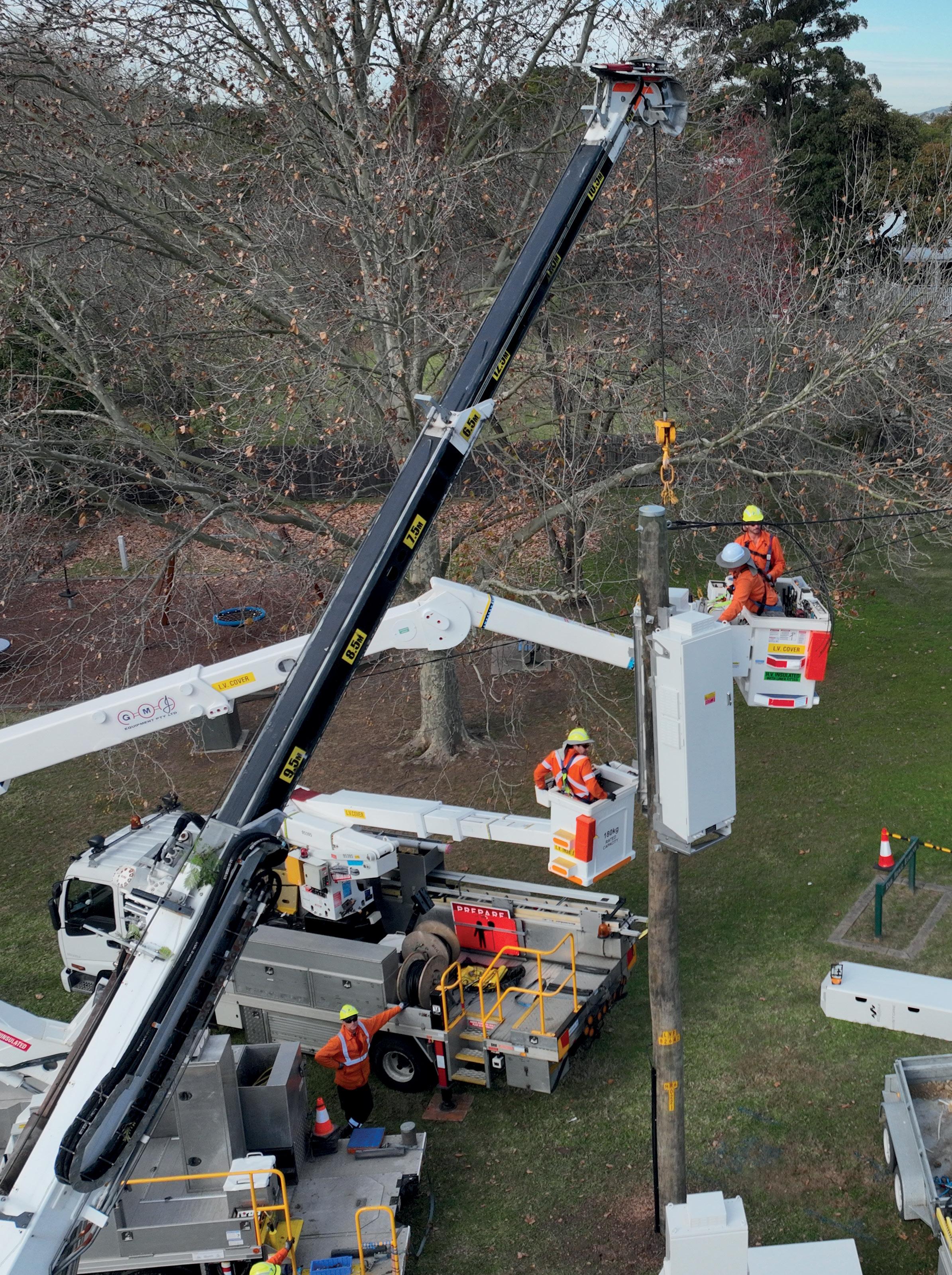

The challenge of decarbonisation rests on us all; industry, government, and households alike across Australia.

e all know that at a macro level, the Australian energy system needs more renewables, and more transmission to connect those renewables and move the energy from where it’s abundant, in the form of sun or wind, to where it’s needed in our towns, cities and industrial hubs. Likewise, to make the increase in renewables possible, we need a lot more storage, to accommodate the time difference between when energy is needed, and when it is abundant.
The 2023 CSIRO Renewable Energy Storage Roadmap report predicts Australia will need six times more energy storage to support the renewable energy transition in order to reach the 2030 target. The forecasts used by AEMO to describe the likely path of decarbonisation show similarly that huge increases in storage, throughout the system, are an inevitable part of a renewable and low carbon future.
At a micro level, in homes across Australia, consumers are also electrifying their homes and vehicles, and for good reason; there is a wealth of evidence and piles of research that show electrifying a household’s assets and home goods –everything from cars to stove tops and hot water – will have positive carbon reduction and financial benefits.
WStudies show a fully electrified home has an annual average running cost of $1,850, as opposed to a gas and petrol home which has an average running cost of $5,300. Over ten years, that’s a saving of $34,500 and, more importantly, a 95,550kg reduction in carbon dioxide.
So, we can be confident that consumers will continue to reduce their overall energy costs over time by increasingly electrifying their lives, and we will continue to see increasing penetration of rooftop solar, which likewise drives energy bill savings and decarbonisation benefits.
Whilst increased penetration of rooftop PV reduces carbon emissions, it also reduces system demand during the day, often creating reverse flows in the network and over-voltage conditions. The so-called ‘duck curve’, or the hollowing out of energy demand in the middle of the day, adds to the costs of solving the decarbonisation of the macro system.
This shows that without thoughtful planning and careful consideration of the whole-of-system costs to decarbonise, our efforts in different parts of the system can inadvertently make our efforts in other parts harder or more expensive.
There are several implications of the changes that will happen through consumers choices around electrification and solar PV uptake:
» As homes increasingly electrify, we will see more localised network constraints and increased system peak demand driven by increased energy consumption
» Adding to this the take up of electric vehicles will add load that contributes both to localised constraints and system wide peaks
» While the additional demand will likely build on existing evening peaks, when customers come home and heat their homes, cook dinner and charge their cars; solar PV will continue to hollow out demand during the middle of the day
The question we must answer is how best to design an energy system which accommodates those micro changes, while also delivering ‘macro’ system decarbonisation.
We know that one of the answers is storage, but not just how much we need, but importantly where in the system we put it, and that is because where we put it can have big impacts on how much we need, and how much it costs.
Batteries are scalable and flexible solutions. They respond faster than any other energy storage or generation technology, turning on and off in fractions of a second, helping to maintain grid stability wherever in the network they are positioned.
But batteries connected to the distribution network, both small community size and medium scale (<5MW), address the local challenges of higher peak demand and the hollowing out of system demand during the day; supporting the network during peak times and avoiding

the need for network augmentation that would otherwise be necessary to address grid constraints. They also help manage voltage and power quality, which can otherwise be challenged by the increased customer energy resources connecting to the grid. They do this while, through orchestration, also being able to provide the macro system with the support envisaged by utility-scale, high voltage transmission connected, super batteries. Every localised network issue they address contributes to solving the macro issues associated with the intermittency of renewable generation. It really is the two birds, one stone analogy in action.
The logic of distributed storage is strong, much stronger than distributed generation, especially when coordinated and orchestrated, to smooth out time differences between supply and demand, while responding meaningfully to network challenges which would otherwise need additional investment to address.
In New South Wales utility-scale storage is expected to grow rapidly in the next five years to around 16GWh (excl. Snowy 2.0 and long duration storage) – then from 2030 onwards, distributed individual (behind-the-meter) batteries are expected to make up the majority of the capacity, totalling almost 50GWh. If we brought half these small batteries together and collocated them as larger shared and distributed community batteries, we estimate that New South Wales customers could save almost $20 billion (based on today’s prices) in battery costs alone. That is before we account for the additional
network and system savings distributed batteries can drive.

With three – soon to be nine –community batteries across the Ausgrid network, these systems will begin to do the heavy lifting. We can expect at least 400 more battery solutions in suburbs across Australia thanks to the Federal Government’s Community Batteries for Household Solar Program. This should just be the beginning of this trend, the Ausgrid network alone has the potential for >2 GW of battery storage capacity (distribution network connected).
Unlocking the powerful co-benefits of small to medium sized batteries is a top priority for Ausgrid and should be for networks across Australia. We are

already seeing the system advantages that come from the coordination of distributed resources within the distribution network. Ausgrid’s project Edith is currently showcasing the benefits that dynamic network tariffs, reflecting local network conditions and constraints on a five-minute basis, combined with the price signals from the National Energy Market, can deliver.
Distributed batteries have a huge role to play in driving this value, but the speed of delivery, ease of coordination, scale of response and the total cost, all improve as they get bigger. People therefore may argue that the focus should be on installing large-scale batteries. However, once batteries get so big that they need to connect at higher voltage, or higher up in the energy system, their ability to positively impact constraints, address local challenges and reduce costs across the system quickly decline.
At Ausgrid, we are very confident in our belief that a sweet spot lies in the low voltage network and at distribution substation level, and that is what we are looking to prove through our ongoing battery program. There will be other changes needed, including tariff and other market reform, the increased use of dynamic connections amongst others, but the financial savings, of many billions, compared to behind the meter batteries is a prize worth pursuing.
If we get this right, distributed small and medium scale battery deployment has a huge role to play in a least cost transition to a decarbonised system by delivering a more dynamic network which is actively responsive to both the energy market and its customers changing needs.
Investing in a high-quality, durable energy storage system is a no-brainer, and new CEC-certified lithium iron phosphate batteries have landed exclusively to one Australian and New Zealand distributor offering an all-in-one solution.
The latest addition to R&J Batteries’ growing portfolio of high quality and technologically advanced products is Koyoe Energy.
Koyoe Lithium Iron Phosphate (LiFePO4 ) energy storage batteries have been specifically developed to provide high performance, longevity and safety in both residential and commercial settings. R&J Batteries is the exclusive distributor of Koyoe Energy in Australia and New Zealand.
Koyoe Energy and its subsidiary, Australian New Energy Technology (ANE), have a combined experience of over 40 years in the energy sector. They take pride in their R&D capabilities and are committed to the continuous innovation of energy storage technology. Koyoe Energy and ANE manufactures a range of high-quality energy storage solutions that meet the needs of households, businesses and industries.
“It is exciting to be able to offer a product of the quality of Koyoe, which ticks all the boxes. This product covers all facets of energy storage from residential to commercial and industrial. It can be used in off-grid and on-grid applications. This is a product which will appeal to the whole market,” Justin Skaines, R&J Batteries Energy Storage Manager said.
R&J Batteries Chief Executive Officer, Stuart Hamilton, said R&J Batteries prides itself on partnering with the best manufacturers from around the world.
“Koyoe is no exception. The Koyoe range of lithium products and inverters is a wonderful addition to our ever growing portfolio. We are delighted to be Koyoe’s distributor across Australia and New Zealand.”
The one solution
A standout product from the Koyoe range is the All-in-One Solution. Developed specifically for residential and small commercial energy storage needs, the Allin-One Solution offers scalability, longevity and reliability. One of the main features of the All-in-One Solution is its modular design. Each module can be removed, purchased or installed individually compared to competitor products in the market which require maintenance of the entire unit.

The All-in-One energy storage system is available in single phase 5kw inverter with 10kWh storage and three phase 10kw inverter with 20kWh storage options for both indoor and outdoor installations.

Koyoe energy storage batteries have backing from some of Australia’s most trusted organisations. It has gained CEC certification from the Clean Energy Council which enables the batteries to be included in Federal and State-based home energy storage schemes such as Solar Victoria’s Solar Homes Program and the Home Battery Scheme in South Australia. All these highlight Koyoe’s commitment to building a cleaner future through greater access to renewable resources.

Koyoe Lithium Iron Phosphate (LiFePO4) energy storage batteries are now available in Australia and New Zealand, with R&J Batteries as the exclusive distributor in the region.
The range of energy storage products from Koyoe has been specifically developed for high performance, longevity and safety from households right up to commercial and industrial businesses

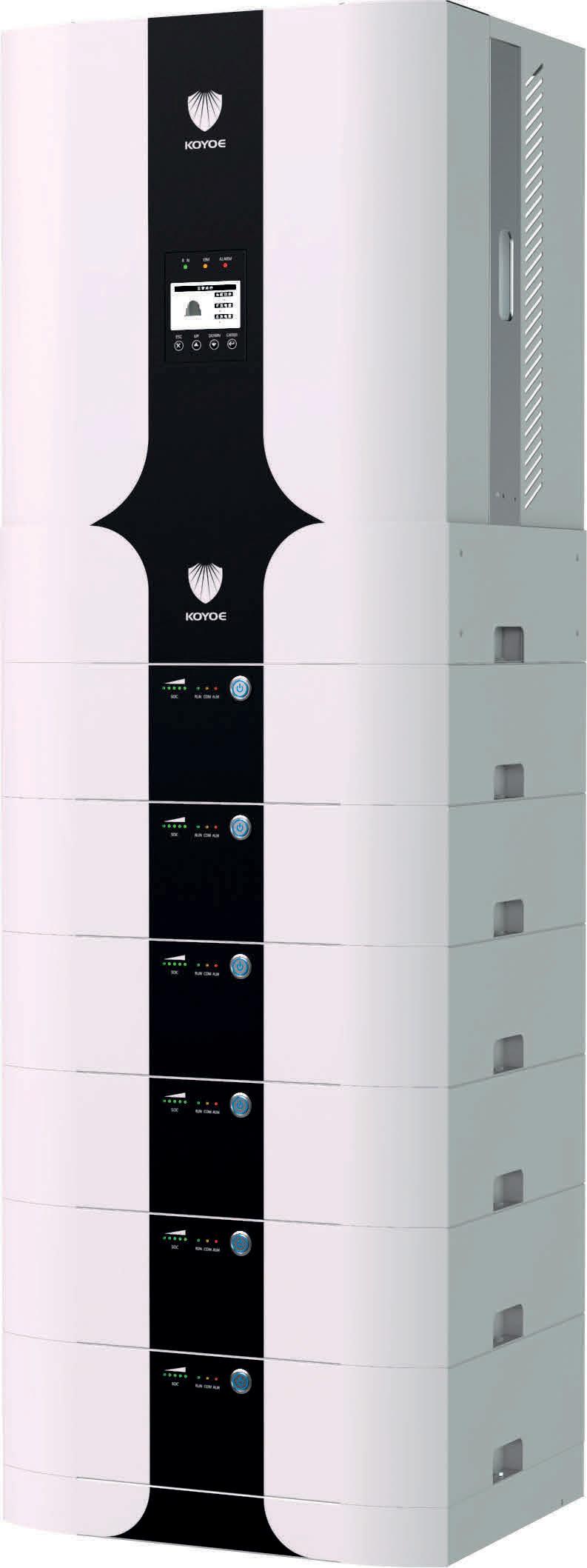
Communication Efficient Fireproofing

Stack Design Performance
BEST PRACTICE APPROVED
 By Marnie Shaw, William Ertler and Louise Bardwell, Australian National University and Baran Yildiz, University of New South Wales
By Marnie Shaw, William Ertler and Louise Bardwell, Australian National University and Baran Yildiz, University of New South Wales
Australia has the highest per capita installed capacity of rooftop solar photovoltaics (PV) in the world. However, the majority of this energy is generated when many residents are at work with minimal household electricity demand and not available during times of peak electricity demand, such as in the evening when residents return home.
To ensure Australia’s rooftop solar capacity is used optimally, households and energy market stakeholders must leverage new strategies and technologies to help fix this mismatch between solar generation and household electricity use. One of the most common and effective of these technologies is battery energy storage.
Batteries enable houses to store excess solar generation locally to be discharged during peak periods, potentially reducing network congestion, lowering electricity bills and reducing emissions.
Many towns around Australia are uniting to take ownership of the energy transition and to make change on a local scale. Located in north-east Victoria, the town of Yea has a small population of around 1,600 people. Its community group, 2030Yea has a big goal of powering its local area with 100 per cent renewable energy by 2030.
In determining the best pathway to achieve Yea’s goal, the group commissioned a report by our team of ANU academics and researchers to investigate the feasibility of a community battery in Yea.
Community batteries are medium-scale batteries (0.1 to 5MW) situated in the low voltage distribution network that are owned, operated and/or governed by a community for community benefits, such as supporting the integration of rooftop solar.
An unexpected finding in our work was that the peak electricity demand in Yea does not occur in the evening, as we typically see in our metropolitan cities. Rather, peak demand occurs around 1am and is due to electric off-peak hot water heating (Figure 1). The effect of the old off-peak tariff period from 11pm to 7am can be seen through the spikes in load at 11pm, the early morning hot water heating peak, and the load dip at 7am from when appliances were set to switch off.

It turns out that this is the case for many regional towns in Australia that have never been on the reticulated gas network. We therefore estimated that moving hot water heating to the middle of the day could effectively soak up Yea’s excess solar generation and that this change would have a significant impact on the size of the battery storage that would be needed in Yea.
Indeed, through our modelling, we found that if the town’s hot water heating was shifted to peak solar hours, the total battery storage required to achieve 100 per cent renewables could be reduced by up to 80 per cent under ideal conditions1
By reducing the required battery capacity, this shift could also reduce the embedded emissions associated with the battery’s material parts and production and end-of-life, as well as concerns around the availability of critical minerals like lithium.
In determining the viability of this option, it was also very important to ensure that households would not be worse off financially by shifting their hot water heating time. This was, after all, the main reason hot water timers were originally set to the off-peak time of around 1am.
In our modelling, we found that, under new tariffs in Victoria which have off-peak prices for solar hours, households were also, on average, better off financially if they shifted their hot water heating to solar hours.
For the township of Yea in Victoria, our modelling clearly suggested that it would be worthwhile for town residents to shift their electric hot water heating to solar hours to soak up their abundant rooftop solar power generation and to minimise the total amount of battery storage required to achieve 100 per cent renewable energy in their town.
Our work with 2030Yea also highlights how not all solutions to achieving 100 per cent renewable energy require fancy technologies, and that a lot can be achieved through clever shifts in how we think about and use our energy. This adaptive thinking will be important in ensuring that our future energy systems are sustainable and not unnecessarily resource intensive.
William Ertler, who led the research, was previously an ANU Engineering student and is now a graduate renewable energy engineer at Jacobs. Mr Ertler was supervised by Associate Professor Marnie Shaw from the ANU Battery Storage and Grid Integration Program. Louise Bardwell works as a Research Assistant at the ANU Battery Storage and Grid Integration Program. Baran Yildiz is a Senior Research Associate at UNSW and is currently involved in an ARENA project 2, looking at dynamically managing hot water systems in South Australia.
https://apvi.org.au/solar-researchconference/wp-content/uploads/2023/02/Ertler-Shifting-domestic-electric-water-heating-to-solar-hoursreduces-battery-capacity-requirements-by-80-a-case-study-in-regional-Victoria.pdf
2.
https://arena.gov.au/news/dynamically-managing-hot-water-systems-in-south-australia/
Developing more sustainable and energy efficient ways to store and use energy does not always have to require fancy or complex technologies. A recent collaboration from the Australian National University and a regional Victorian town has had surprising and positive results in proving that moving electric hot water heating from nighttime to during solar hours has the potential to massively reduce required battery storage.Figure 1. 15-minute average daily load in Yea for 2018 with a standard error of mean. Data was provided to ANU by 2030Yea and AusNet. 1. Australian National University, 2022, Shifting domestic electric water heating to solar hours reduces battery capacity requirements by 80%: a case study in regional Victoria Australian Renewable Energy Agency, 2023, Dynamically managing hot water systems in South Australia,
Evolving an entire transportation industry is no small feat. State and territory governments, leading energy organisations and experts have been working in recent years to ensure Australia’s passenger transport future is electric, but there is a piece missing from the puzzle. In April 2023, the Federal Government, after long industry and consumer consultation, released the country’s first Federal National Electric Vehicle Strategy. Finally outlining the work ahead to legislate a fuel efficiency standard and more, the strategy shares Australia’s plan to grow the uptake of electric vehicles (EVs).
With determined outcomes and promises of federal, state, and territory collaboration, the strategy and the development of fuel efficiency standards will help propel Australia’s transport sector forward and support the wellbeing of Australians. Not only will the strategy help reduce transport emissions and make it easier to buy and charge EVs across the country, it will help save Australians money on ever-rising petrol prices.
In 2022, EVs made up only 3.8 per cent of new car sales. Compared to the 15 per cent in the UK and 17 per cent in the EU, Australia is far behind. Individual states and territories have already set their targets, including the Queensland Government, which is aiming for EVs to be 50 per cent of new passenger vehicles by 2030.
Set to help ease purchasing and access barriers for EVs across the country, the objectives of the strategy are threefold; supply, demand, and systems and infrastructure. The three pillars are set to be supported with both new initiatives alongside ones already established.
The first pillar concerns increasing the access of affordable EVs by developing Australia’s first fuel efficiency standards for new light vehicles and supporting recycling, reuse and stewardship initiatives for EVs and other large format batteries. Fuel efficiency standards limit the amount of carbon dioxide vehicles are permitted to emit.
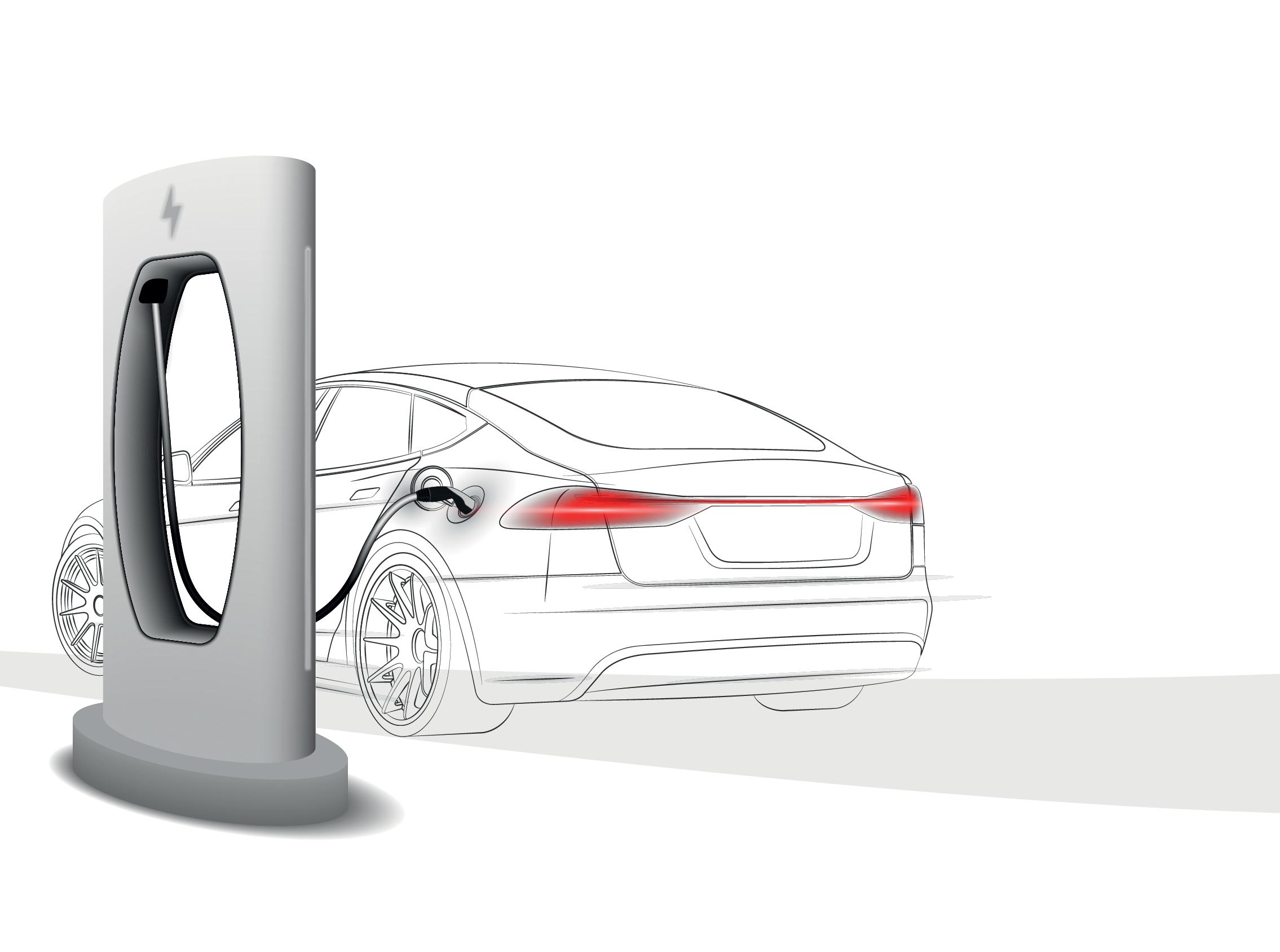
Australia doesn’t currently have standards and cars on Australian roads, on average, produce significantly higher emissions compared to the rest of the world. This also means that the global car market does not see supplying Australia with EVs as a priority in comparison to countries that already have standards established.
The Federal Government said a “well-designed standard will help reduce fuel costs for Australian motorists and improve the supply and variety of EVs coming into the Australian market”. Due to the lack of standards, there has also been less pressure on the Australian transport sector to decarbonise and introduce low-emission vehicles, leading to lower EV interest and continued higher emissions.
The Electric Vehicle Council (EVC), Climate Council and Smart Energy Council, among others, have been calling for a standard to be implemented for years.
Following the publication of the strategy, the Smart Energy Council said there was no time to wait, and called for it to be implemented as soon as possible.
“The longer these standards are delayed, the greater the emissions reduction task and the longer Australians will have to wait for better electric vehicle supply and cheaper fuel bills,” a statement said.
“If the Federal Government had introduced fuel efficiency standards in 2016, Australia would have saved more than $6 billion in fuel costs, and avoided 4,000 megalitres of imported fuel and nine million tonnes of greenhouse gas emissions – similar to the emissions footprint from domestic aviation.”
Climate Council Head of Advocacy, Dr Jennifer Rayner, said the lack of standards has caused Australia to become a “dumping ground for expensive, polluting, petrol-guzzling vehicles”.
“Strong fuel efficiency standards are the key to unlocking supply of the cleanest and cheapest-to-run cars for Australia – including electric ones,” Dr Rayner said.
“The Federal Government and industry will be driving with a flat tyre in trying to deliver the rest of the National Electric Vehicle Strategy if we don’t get these in place soon.”
The EVC, in its strategy response paper, said the Federal Government “must model the emissions reduction that will be delivered by the [strategy design] and how this aligns with its floor (minimum) targets of 43 per cent by 2030, and net zero by 2050”.
With its own modelling completed in June, the EVC said if the strategy was consistent with matching the US and EU this decade, it could expect to “deliver well over $10 billion in total net benefits by 2035, with a cost benefit ratio of greater than 2.5”.
EVC CEO, Behyad Jafari, said getting the fuel efficiency standards right will put “Australia on the path to a brighter transport future for decades ahead” and has the potential to unlock significant domestic manufacturing and opportunities.
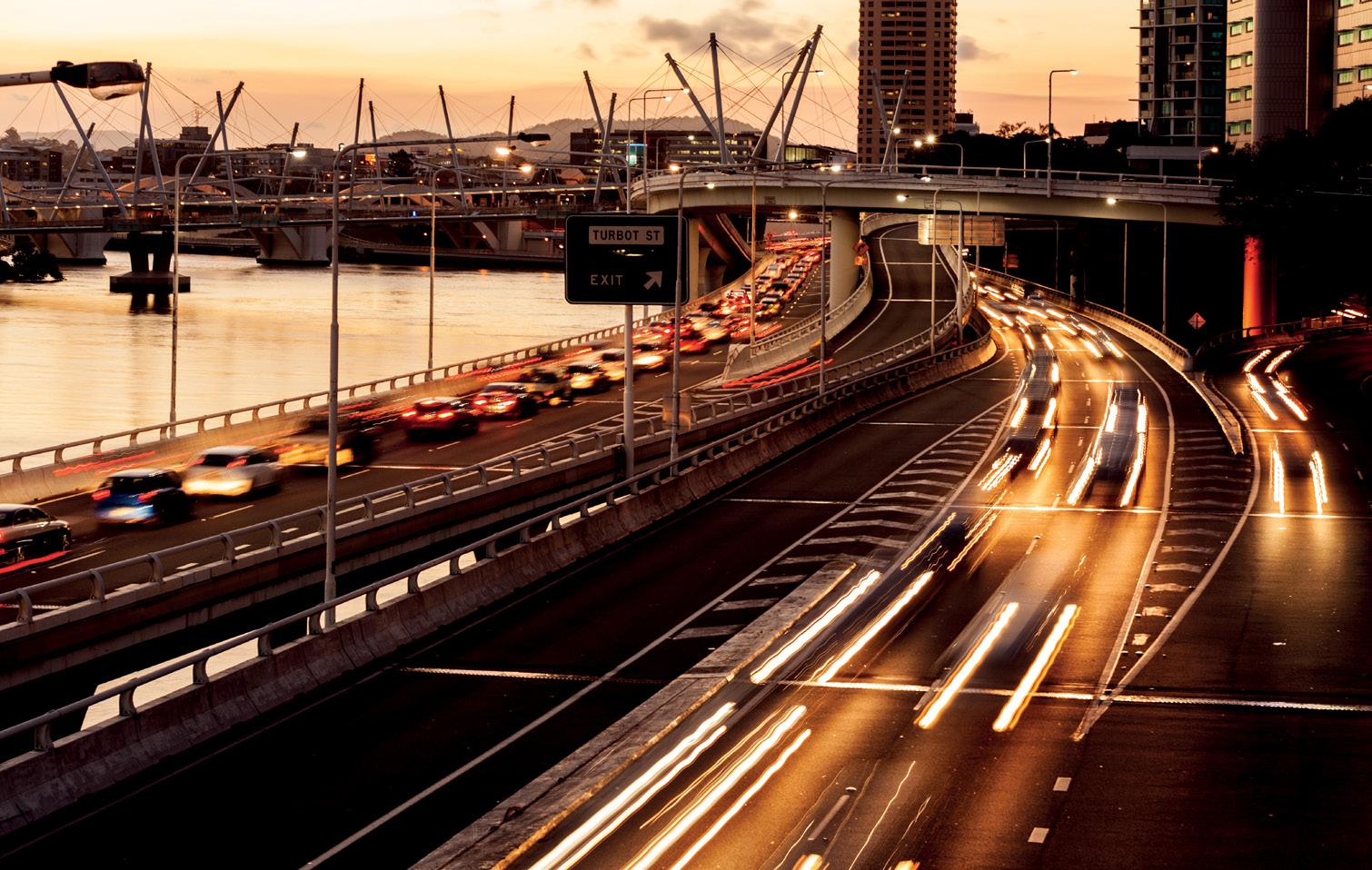
Creating a fuel efficiency standard and ensuring supply is supported is only part of the challenge. Resources, systems and infrastructure need to be put in place to support the rapid EV uptake.
Many companies across the country are already investing in their own charging stations and infrastructure, including AGL, Ampol, Evie Networks, Origin and bp, and the continued industry support will also complement Australia’s uptake of EVs.
The Federal Government said its work towards the infrastructure goal will include its own new initiatives on a national mapping tool for optimal investment and deployment of EV charging infrastructure nationwide.
Australian residents without their own roof are also supported in the strategy, with the Federal Government set to undertake new research to enable the EV uptake for residents of existing multiresidential buildings.
By building the EV supply, and backing them up with proper systems and infrastructure, the Federal Government’s alreadyestablished acts and legislation can better support the demand for EVs. This includes the Driving the Nation Fund, New Energy Apprenticeships and New Energy Skills Program, nationwide government collaboration to ready the electricity grids, the 117 EV charging highway initiative, Electric Car Discount, EV purchasing incentives and subsidies, as well as the Federal Government’s zero interest loans.
Part of the push to ensure a fast implementation of fuel efficiency standards has been the significant call for strong penalties for suppliers and manufactures who do not reach vehicle emission guidelines.
As part of fuel efficiency standards, a supplier which beats the standard by selling more efficient vehicles and low to zero emission vehicles (LZEVs), will be rewarded – usually through ‘credits’. It’s important to note that new standards only impact new vehicles, and do not include those already on the road.
The Smart Energy Council and EVC said penalties for not reaching the guidelines should exceed the cost of standard compliance, and roughly align with the penalties seen in the US, Europe, and New Zealand.
Further penalty suggestions from the Smart Energy Council included “mandatory public announcement of non-compliance, and exclusion from Government fleet purchases”.
The EVC has recommended greater transparency to allow for a smoother transition for consumers and industry stating, “fewer concessions/bonus credits will provide greater visibility of the true emissions rates of new vehicles for both car makers and consumers”.
The Federal Government has outlined the plan ahead for proper integration of EVs into Australia to include:
» Delivering nationally consistent and, where possible, internationally aligned standards and communications protocols for EV supply equipment (EVSE), cybersecurity, and smart functionality
» A common mechanism for EVSE data sharing
» A nationally aligned Service and Installation Rules
» Streamlining network connection processes for consumer energy resources, including EVSE
» The Net Zero Government Initiative and a new goal of 100 per cent zero-emission Government vehicle fleet by 2035
The Federal Electric Vehicle Strategy has a long, winding road ahead to legislate change. Reducing the upfront costs of EVs, ensuring effective and efficient charging infrastructure across the country, and making clear and firm fuel efficiency standards will help accelerate Australia’s transition to an electric future and ensure we can match global pace.

The electrification of transport is a key weapon in the armoury to decarbonise many a country’s economy, and Australia is no different. With around 20 million vehicles on the road and 99.9 per cent of these powered by petrol or diesel, Australia’s carbon emissions from road transport have been on a seemingly unstoppable rise for decades. A new project funded by the Reliable, Affordable Clean Energy for 2030 Cooperative Research Centre (RACE for 2030) will demonstrate how the strategic integration of electric vehicles (EVs) with the electricity grid and energy storage can accelerate the decarbonisation of Australia’s road transport sector.

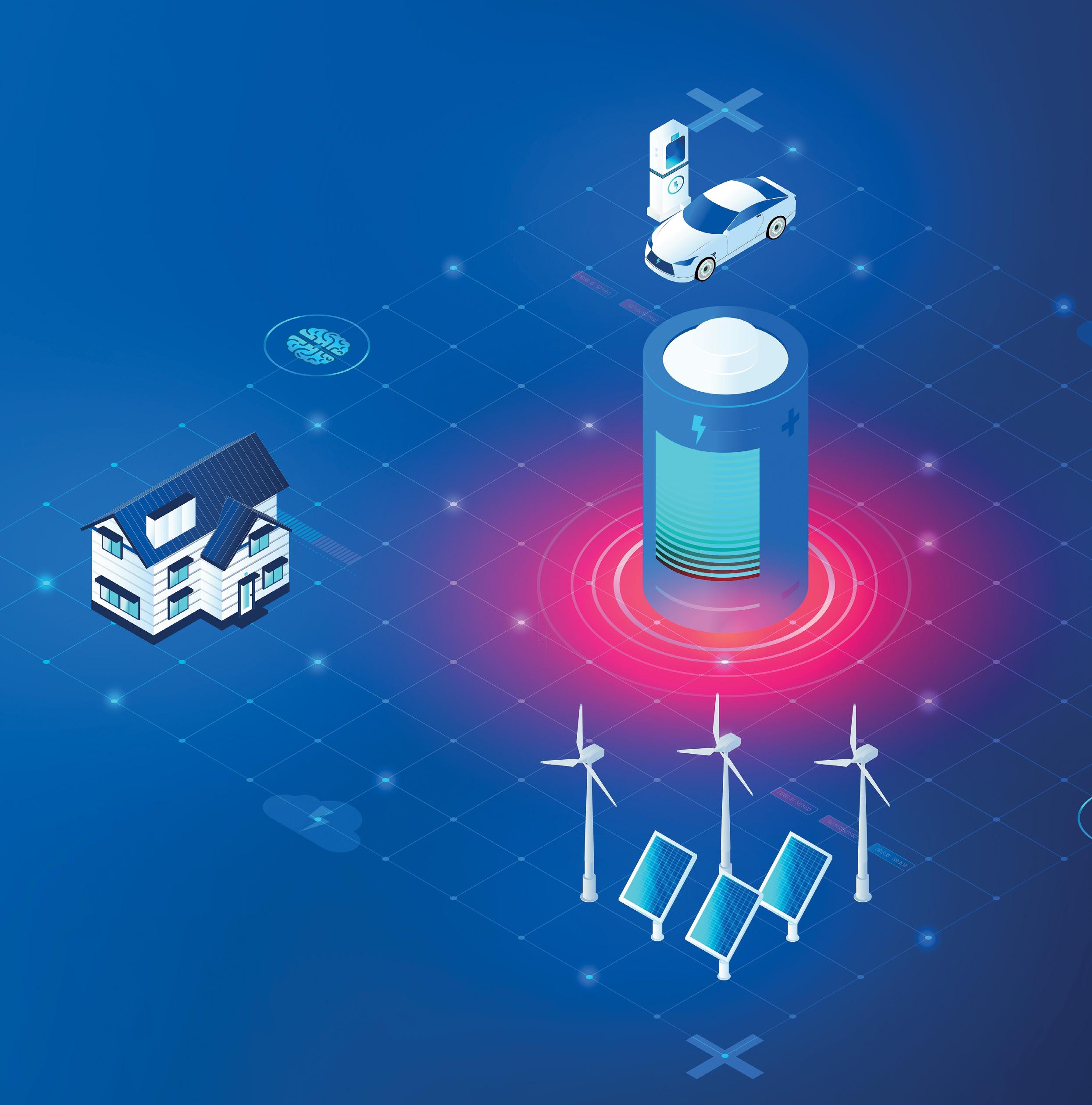
EVs, combined with a rapidly decarbonising electricity grid, offer an opportunity to tackle this highly polluting sector head on but also poses numerous challenges.
The Reliable, Affordable Clean Energy for 2030 Cooperative Research Centre (RACE for 2030) was established in 2020 and is the largest of its kind. Its mission is to create transformative and sustainable change in the energy sector by increasing the penetration of renewables and the reliability of the grid while reducing energy costs and carbon emissions. In order to do this, it has secured $68.5 million in Federal Government funding and attracted $280 million from its partners who have been drawn from industry, state governments, and academia. By 2030, it aims to have delivered $3.8 billion of energy productivity benefits and 20 megatons of carbon emission savings.
One of the RACE for 2030’s keystone projects is the Australian Strategic Electric Vehicle Integration Project (SEVI).
Starting this year, SEVI is a three-year, $3.4 million project that is investigating how EVs can be best incorporated along with renewable energy generation and
stationary battery storage. The research project will be undertaking deep dives into promising early EV customer use cases that have been identified as having high potential for replicability and scalability. These use cases will feature business and government fleets, holiday parks, and residential developments in New South Wales, South Australia, and Western Australia respectively.
From electricity network distribution companies to industry skills bodies, from technology developers to state and territory governments. The types of organisations who are part of this project is indicative of how the growing adoption of EVs has wide ranging potential benefits for a host of different sectors. Those who have committed time and funding to the project are Ausgrid, the Australian Power Institute, Endeavour Energy, Planet Ark Power, Powertech Energy, the New South Wales Government, South Australian Government, Selectronic, SA Power Networks, SwitchDin, Plico Energy, Western Power, and the Witchcliffe Ecovillage.
The overall project has been designed and led by industry research specialists from the UTS Institute of Sustainable Futures and the Curtin University Sustainable Policy unit. The other researchers in the team are drawn from Griffith University, Monash University,
RMIT University, and the University of South Australia. Each member of the multi-disciplinary research team has been selected by the research leads, all of whom are experts in the field and have a track record of successfully working together.
As the SEVI project features demonstrations run across the three states, the researchers will be applying a range of methods to understand how EVs can be most effectively integrated alongside solar and stationary batteries in the different use cases.

Social researchers will examine EV user values, motivations, and behaviour when it comes to vehicle use and charging.
Power systems researchers will investigate how the charging of EVs impacts on the low voltage distribution grid, especially when combined with solar PV and stationary batteries.
Business and economics researchers will analyse the business models for the different use cases, while energy modelling experts will assess the wider impacts at the national energy system level.
Policy and legal experts will take the findings from all the research outputs and synthesise what this means in terms of recommendations for policy makers concerned with transport decarbonisation and electrification.
Australian adoption of EVs is slow compared with other developed economies, with a variety of reasons often cited for why electrifying its road transport faces unique challenges.
Australia is one of the largest countries in the world, sitting between Brazil (over 200 million people) and India (1.4 billion) but with a relatively small population of just over 26 million. This means a low population density and a challenge for the provision of charging infrastructure compared with smaller countries with more people per square kilometre. Our cities can be dense, and with 85 per cent of the population living in metropolitan areas, this poses other challenges for EV infrastructure provision – such as how to service apartment dwellers or how to balance the needs for reducing congestion on inner city roads.
The Australian grid is also unique as the longest interconnected electricity system in the world at over 5,000km in length and over 40,000km of poles and wires. Getting the electricity from where it is generated to where it is needed has always been a challenge given its enormity. Effective integration of distributed energy resources, whether solar systems or EVs, is needed to ensure that system security and reliability is maintained or improved, emissions are reduced, and consumer costs minimised.
Australia’s public roads are also similarly vast, amounting to nearly 880,000km which puts it in the top ten of countries with the largest road network in the world. With a relatively small population, many communities could be left traversing charging infrastructure blackspots without suitable strategies and policies to tackle this.
However, alongside these challenges are also some features that makes Australia well suited for EV adoption and gives it good reason to support the move away from fossil fuel powered road vehicles.
Australia has a wealth of the resources that will be critical for the transition to more decentralised, distributed, and decarbonised energy and transport sectors. In terms of the renewable resources that are used to generate electricity, we have some of the best solar and wind resources in the world. Almost 3.5 million households (over a third) have chosen to have solar installed on their rooftops across Australia to take advantage of this with scope for hundreds of megawatts more. This gives greater impetus to households to want to electrify their vehicles to take advantage of the clean, free electricity their solar systems offer.
However, those solar panels and EV batteries rely on a variety of precious and rare minerals that must be mined but are abundant within Australia’s borders. This includes lithium, where we produce over 50 per cent of the world’s supply, as well as cobalt (20 per cent), aluminium (27 per cent) nickel (23 per cent) and copper (11 per cent). There’s opportunity and advantage to supporting this transition for the country.
Through these carefully selected practical demonstration projects, SEVI will build on the growing evidence from other EV integration projects nationally and internationally, moving the research beyond early adopters while applying it to the Australian context. This will seek findings that can help both city and rural EV users, small and large businesses, and solar and non-solar households. Through this approach we can better understand how to take advantage of all the opportunities on offer, while ensuring that EVs can be integrated equitably to benefit all Australians rather than a few.


Most of us are familiar with the green and gold kangaroo or the Health Foundation tick. These quickly identifiable certification schemes are designed to give customers confidence in the product they are purchasing, with the assurance that the “premium” products they buy are what they are purported to be. Australia’s hydrogen Guarantee of Origin scheme would work in much the same way. The scheme is under development and will be an important tool in the policy toolbox to support the transition to renewable gas.

The Federal Government has been consulting on the design of a Guarantee of Origin (GO) scheme for hydrogen over the past two years. In the recent federal budget, it allocated $38.2 million over four years from 2023–24 (and $6.5 million per year ongoing) to establish the certification scheme. This would be designed to track and verify hydrogen emissions and other low-emissions products (based on hydrogen), and provide an enduring mechanism to certify renewable electricity.
The proposed GO scheme will be voluntary and established under new legislation administered by the Clean Energy Regulator (CER). It will start with coverage of hydrogen, hydrogen energy carriers and renewable electricity and is proposed to expand.
The GO scheme includes two new certification types –renewable electricity GOs and product GOs.
A renewable electricity guarantee of origin (REGO) certificate mechanism would provide certainty for renewable electricity investment and procurement. The proposed REGO certificate would build on the Large-scale Generation Certificate (LGC) framework under the Renewable Energy Target (RET). The new mechanism would provide organisations with certainty about how renewable electricity would be recognised after 2030. This could support planning, contracting and investment decisions being made by businesses today. It would provide an enduring mechanism for the tracking, verification and trade of all renewable electricity generation in Australia.
Product GOs will verify the carbon intensity of products across their life cycle. The scheme aims to capture emissions associated with the supply of raw materials, production and transport and storage to the point of consumption or international departure –well-to-user. The product GOs may adopt a provenance approach where certificates could be traded alongside the product itself while having the flexibility to recognise that molecules may be interchangeable in certain situations.
The GO scheme is designed to be a product-based emissions accounting framework that measures and tracks emissions and associated information across the value chain. The scheme would enable producers to make credible low emissions claims about their products, unlocking opportunities for trade, decarbonisation
and investment. The proposed scheme has been developed in close collaboration with international energy partners to ensure it meets their needs as importers of Australia’s clean energy. The Federal Government worked with the International Partnership on Hydrogen and Fuel Cells in the Economy (IPHE). The IPHE is working with countries to determine the carbon emissions from hydrogen production.
The proposal is for a streamlined, upfront reporting model that minimises administrative burden for participation while maintaining accuracy and flexibility. The scheme is intended to be legislated by the start of 2024.

The International Renewable Energy Agency (IRENA) notes that the climate benefit of hydrogen depends on the emissions footprints of the method and energy source used to produce it and this footprint varies widely across pathways. Capturing sustainability criteria in a product certificate is necessary to establish low-carbon or renewable hydrogen as desirable commodities; for renewable hydrogen, certificates provide a marketable characteristic for hydrogen consumers looking for green products.
There are a range of hydrogen certification schemes (voluntary and involuntary) under development that aim to define low-carbon and renewable hydrogen. Their technical criteria vary in scope, emissions thresholds and accounting methodology – the same label might not refer to the same product with the same threshold in different schemes. Different schemes could also include additional environmental, social and governance criteria, which are not easily comparable with other schemes.
There is currently no hydrogen certification scheme suitable for international trade. Further work needs to be undertaken to develop a hydrogen certification scheme which encourages international trade. Many countries are currently working on hydrogen certification schemes, including Australia, Japan, China, EU, UK, US as well as the International Green Hydrogen Organisation.

At least 60 countries have published or are drafting hydrogen strategies, with several aiming to establish themselves as hydrogen exporting regions. Most of the strategies include consideration of a certification scheme to quantify hydrogen-related emissions reduction. The EU, UK and the US are in the process of setting a definition of low-carbon and green hydrogen by specifying emissions thresholds and scope.
A patchwork of regulation would impede scaling of renewable hydrogen and have negative impacts on the international trade of hydrogen and its derivatives. If there is no effort to consolidate and harmonise the technical criteria used to classify hydrogen as lowcarbon, there may be formation of markets equal to the number of certification rules in place which would be far from optimal.
The International Partnership for Hydrogen and Fuel Cells in the Economy (IPHE), of which Australia is a partner, is also looking at hydrogen and its production. IPHE’s Hydrogen Production Analysis Taskforce is taking initial steps to develop a mutually agreed methodology for determining the greenhouse gas and other pollutants’ emissions associated with the production of hydrogen. It is hoped that application of this methodology will help facilitate the market valuation and international trade in ‘clean’ hydrogen by recommending a common approach established by several countries.
Australia’s toolbox for renewable gas is growing. The continuing support for the Hydrogen Guarantee of Origin is an important tool that will provide customers with assurances that they are getting a low carbon, or a renewable, gas.
Electrical wellheads submerged in floodwaters, power boxes overheating in 45-degree weather, maintaining ageing infrastructure, meeting rising energy demand – these are just some of the challenges Origin Energy’s Senior High Voltage Engineer Nick Bristow faces in his line of work.

Mr Bristow and his team are responsible for the safe and reliable operation of hundreds of critical high voltage assets for Australia Pacific LNG including seven main substations, 15 gas processing substations, a high voltage kiosk and almost 4,000km of electrical cable.
“There’s no such thing as a typical work week in this area of the business,” Mr Bristow said.
“The focus of our job is to make sure all high voltage equipment is operating safely, and responding to any issues so we can avoid outages.”
For Mr Bristow and the Origin team, this can be anything from investigating circuit breaker faults in the field, to transformer maintenance, or growing the field substations with new infrastructure.
“Our overall goal is to minimise the number of equipment failures that happen and make sure the network's operating smoothly.”
Australia Pacific LNG is the largest producer of natural gas in eastern Australia. Through a network of high voltage transmission lines and power stations, which Mr Bristow and his team work to keep running, Australia Pacific LNG's gas field facilities are powered by electricity from the Queensland electricity grid.
During the Australia Pacific LNG construction phase from 2013 to 2018, Mr Bristow was contracted to work as a commissioning electrical engineer to help bring the project’s Condabri Central Gas Processing Facility online.
Origin was able to reduce the facility’s noise and air emissions, maximise gas production, and ensure reliability by powering gas facilities with power from the grid instead of produced gas.
“It was a very interesting and unique project to work on, and ultimately led me to working at Origin in my current position,” Mr Bristow said.
“Origin manages the upstream operation of Australia Pacific LNG, which is made up of a suite of relatively young assets like the network. But some of the infrastructure has been operating for more than a decade now, so there is more effort needed these days to prevent unplanned outages.
“With this challenge in mind, we are exploring new technologies and methods to better mitigate and respond to electrical disruptions.
“One of these new technologies is a cable partial discharge monitoring system, which is designed to detect potential partial discharge failures and allow us to intervene before the event occurs.”
Cable joints are vital components in Origin’s transmission network and defects in cable joints can lead to a system fault. If a joint starts to fail, the cable partial discharge monitoring system detects the small electric pulse generated and then alerts Origin of the issue so it can identify its location and make plans to fix it.
Mr Bristow also said he and the team benefit from the planned turnarounds
that Origin undertakes on assets to allow maintenance, investigations and repairs to help prioritise and schedule their own maintenance and repairs on high voltage equipment.
“Additionally, we have established a specialised team of high voltage coordinators within Origin to assist with high-risk high voltage work activities throughout Australia Pacific LNG.”

Extreme weather conditions add yet another challenge Mr Bristow and his team have to prepare for, in terms of safety and reliability for high voltage work.
Mr Bristow said this extreme weather, in particular flooding, is an environmental challenge that is always present in his line of work.
“The network has some high voltage assets in areas that have experienced flooding, but as we move forward and technology improves, we're able to approach these challenges differently now than we used to.
“We now have what are called ‘sacrificial assets’ being used at well sites located in areas we are aware have flooded in the past. This allows us to set up wells in these sites with the ability to abandon a voltage feeder – or mainline – in the event of flooding so we don’t have live services in that area.
“With these new controls in place we can go after gas in locations previously out of reach because of the risk of damage to the network.”
Although Mr Bristow has been at Origin for the past four years, he has worked as an electrical engineer for over a decade engaged on a variety of projects and in a range of different roles, including the Victorian Desalination Plant, the Newcrest Cadia Underground Gold Mine, and the Tallawarra gas-fired power plant in Wollongong.
“After graduating from RMIT University I was involved in commissioning the Tallawarra plant as part of my engineering
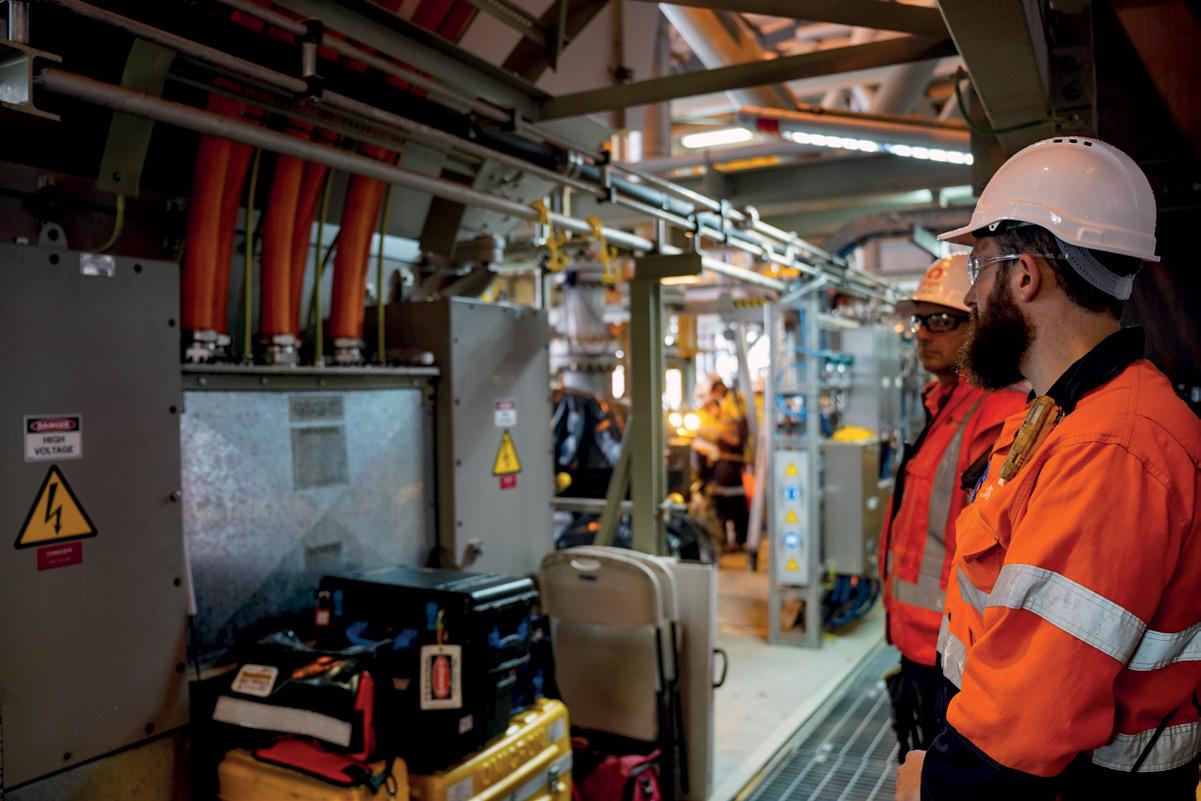
work experience, which was a huge learning curve for me.
“One of the takeaways from that experience that has always stuck with me throughout my career was the focus and attention to safety on that project, with strict lockout tagout protection systems using lock boxes, permit boxes, or similar personal locking centralisation methods to keep everyone safe.

“At Origin, we've invested a lot of time and effort in building a strong safety culture working with high voltage electricity. We look at incidents in Origin and at our industry peers, then formalised those learnings into a safety standard guide to consult.
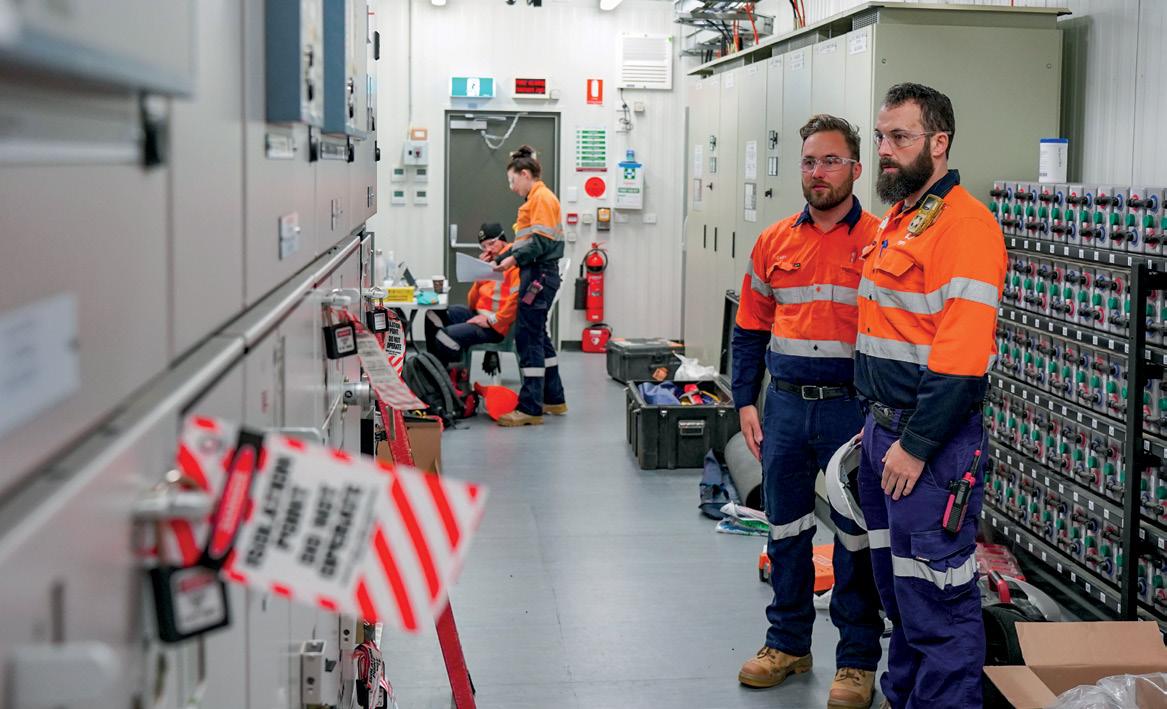
“In the high voltage space there is a lot to learn and improve, and with advancements like adding solar to the network, the future is looking interesting.
“I’m really proud of the work the team and I have been able to accomplish in this space across the Australia Pacific LNG network to date and look forward to meeting the challenges ahead.”
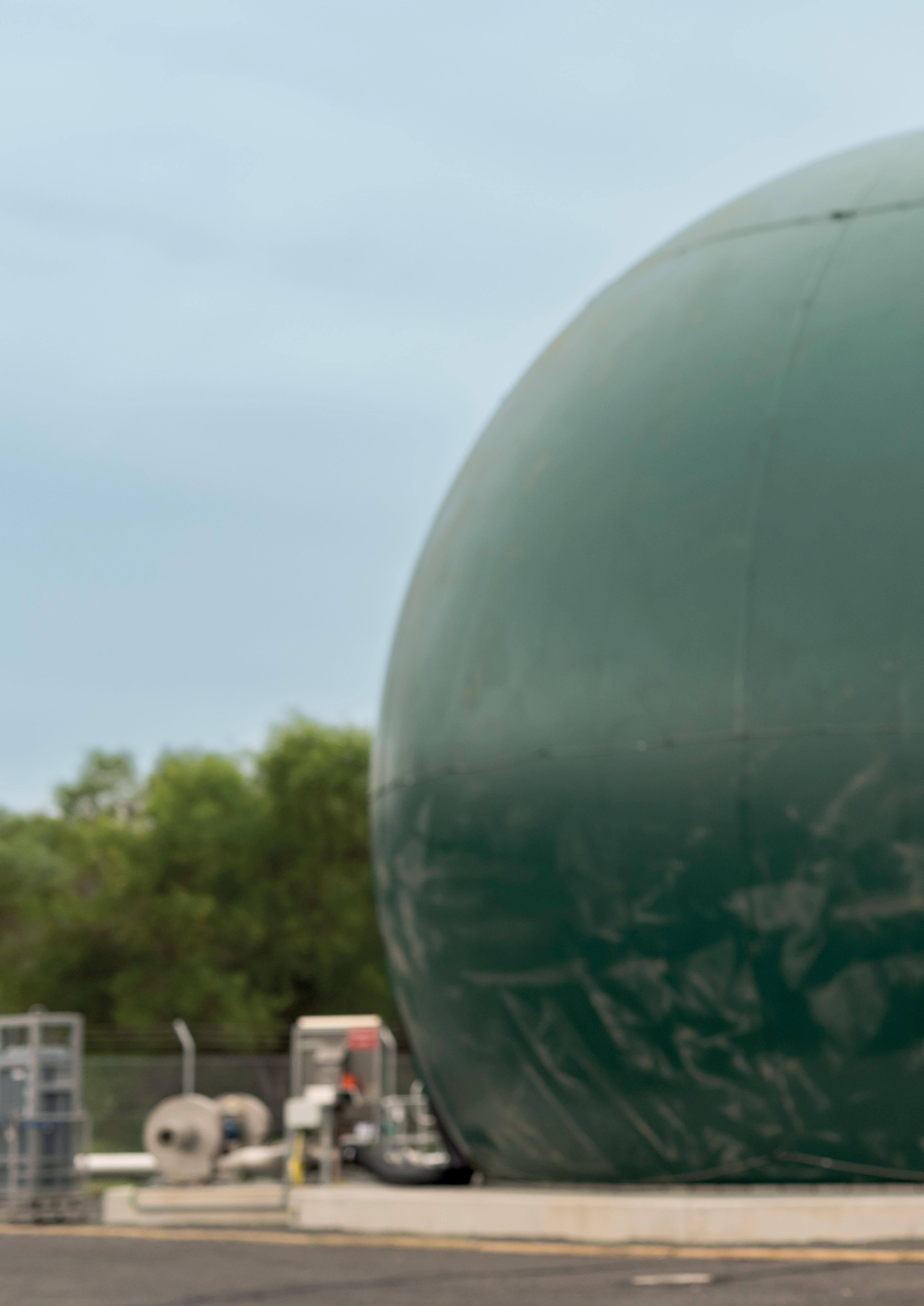
As you walk towards the new Malabar Biomethane Injection Plant, a dark-green dome dominates the scene, stretching up some eleven metres in height. It looks something like a cross between an oversized Swiss Ball escaped from a gym and something that little green men might have landed in recently.

Jemena’s General Manager Renewable Gas, Linda Cardillo, explained that the abrasion-resistant, ultraviolet-resistant and flame-retardant dome is where raw biogas produced at project partner Sydney Water’s Malabar Water Resource Recovery Facility (WRRF) is stored, ahead of having carbon dioxide and other contaminants removed by the upgrader on site.
“In an Australian first, this biomethane is then injected into the Jemena Gas Network, which is something we’re really proud of achieving,” Ms Cardillo said.

“This demonstration project is designed to show the potential for transforming organic waste – in this case, what Sydneysiders are flushing into the sewage system – into a renewable gas that can be used in the New South Wales gas network, and with existing appliances and manufacturing processes.
“We see great potential for a biomethane sector in helping Australia reach its net zero emissions targets.
“Using biomethane in the network means we can put to use the gases that would be naturally produced and released into the atmosphere as organic waste degrades.”
The Malabar Biomethane Injection Plant is a demonstration project, co-funded by Jemena and the Australian Renewable Energy Agency (ARENA), with an initial capacity of 95 terajoules (TJs) per annum – the equivalent to the average yearly gas use of around 6,300 New South Wales homes. Depending on the quantity of biogas Sydney Water can produce on site, this could be scaled up to around 200TJs– equivalent to the average yearly gas usage of around 13,300 New South Wales homes per year.
For many years at the Malabar WRRF, one of Australia’s largest wastewater treatment facilities, Sydney Water has produced biogas onsite through anaerobic digestion – the process through which bacteria breaks down organic matter. Until the new biomethane plant was developed, this biogas had primarily been used to power the facility, with excess biogas burned or flared. Now, this biogas is being upgraded to a quality that meets the required specifications (Australian Standard AS4564:2020) for injection into the natural gas network as compliant gas.
Ground was broken on the project in July 2022, and biomethane meeting the required quality was first injected into the network in June 2023. To design and deliver the facility, Jemena partnered with Zinfra, which led engineering, procurement and construction, including constructing the transfer station and pipeline that enables gas from the plant to be injected into the Jemena Gas Network.
The Zinfra team worked with partners, including Eneraque, to deliver the technology needed to remove contaminants and CO2 from the raw biogas, including the biogas buffer storage dome, the CO2 removal system and a cooling package.
At the time of going to print, the Malabar Biomethane Injection Plant was to become fully operational in a matter of weeks, producing increasing volumes of gas to inject in the network.
Jemena has signed an agreement with Origin Energy for the sale and purchase of biomethane produced onsite, where Origin will offer business customers the option to benefit from the renewable gas.
In announcing the deal in March, Jemena Managing Director, Frank Tudor, said that the company was thrilled to have reached this agreement.
“We received broad interest from a number of retailers when we initially approached the market with an offer to purchase biomethane, and we are thrilled to have agreed to sell the renewable gas to Origin,” Mr Tudor said.
“This announcement is proof that renewable gases, such as biomethane, are commercially viable and that there is significant appetite from the market for it as part of the future energy mix.”
Alongside this sales agreement, Jemena highlights the importance of a nationwide biomethane certification accreditation and certification scheme – similar to how renewable electricity is certified – which would allow customers to count the use of renewable gas towards their emissions reduction endeavours.
Towards this end, Malabar’s biomethane will be the first renewable gas to be assessed through a pilot GreenPower renewable gas accreditation scheme. The GreenPower scheme, scheduled to start in mid-2023, will offer a way for networkconnected commercial and industrial gas customers connected to the gas network to offset the emissions from their gas use.
Ms Cardillo said that Jemena is investing in demonstration projects like Malabar because biomethane is a ‘here-andnow’ option that could help Australia achieve its emissions reduction targets.
“Unlike the perhaps more frequently discussed green hydrogen, biomethane can be used in appliances and manufacturing processes that currently use natural gas, as it has a chemical composition very similar to natural gas, just produced from a renewable resource – organic waste,” Ms Cardillo said.
Biomethane can be produced by capturing biogas from a range of decomposing plant and animal sources – agricultural waste, landfill and waste water.
“When this biogas is captured, processed and repurposed, we’re removing CO2, hydrogen sulfide and other contaminants safely from the gas, and putting the upgraded gas to use for transportation through the network – greenhouse gases that would otherwise be released into the atmosphere.
“And as the volume of biomethane and other renewable gases in the network increases, it will displace fossil fuels.”
According to the Australian Renewable Energy Agency’s Bioenergy Roadmap, released in 2021, Australia’s bioenergy sector has the potential to help to lower emissions by about 9 per cent by 2030.
A February 2023 ENEA report for Energy Networks Australia projects that depending on the level of policy supports in place, enabling biomethane and renewable methane production in Australia could contribute to an overall Scope 3 emissions reduction of up to 31 per cent for the gas industry.
In addition to reducing overall emissions, other potential plusses of biomethane and the development of a bioenergy sector include a potential contribution of around $10 billion in extra GDP each year, the creation of 26,200 new jobs and the diversion of an extra six per cent of waste from landfill.
Jemena’s research has found that in New South Wales alone there are enough potential sources of biomethane – wastewater plants, landfill and food, agricultural, and crop waste – to generate about 30 petajoules of biomethane each year. This is approximately enough gas to meet the needs of all of Jemena’s current residential customers in New South Wales.
This potential is echoed around Australia – the Bioenergy Roadmap states that the country’s theoretical bioenergy resource potential, if harnessed, could be more than 2,600 petajoules per year – more than 40 per cent of Australia’s current primary energy supply.
“Biomethane is a pathway that can’t be ignored in Australia’s race to net zero emissions by 2050,” Ms Cardillo said.
“A lot of current discussion revolves around electrification as being the pathway to get Australia to net zero, but with the scale of the challenge in front of us – including the challenge to reduce emissions for manufacturing sectors that use gas as a feedstock and where electrification isn’t currently an option – we really need to be looking to use every available option.
“The full costs of electrification both for customers at the individual level, and at a systemic level for Australia aren’t well understood – as well as the significant practical challenge for Australia in building the amount of additional electricity infrastructure that would be needed.
Modelling by Frontier Economics - from November 2021 - found that this approach, when compared to the cost of full-electrification, would see consumers avoid between $12 billion per annum in systems costs.
“We can see this hybrid approach internationally,” Ms Cardillo said.
“While biomethane might be in its early days in Australia, it is widely acknowledged as a viable source of renewable energy, and an important part of a future lower-carbon energy system, in many countries, particularly in Europe and the United Kingdom.”
In Denmark, for example, biomethane supplied more than 25 per cent of gas demand in 2021, and this is projected to increase to 70 per cent or more by 2030. In the UK, more than 80 biomethane plants are connected to their gas grid.
While that level of production is still in Australia’s future, Jemena hopes that having the country’s first biomethane-to-gas-network project up and running will ignite a new renewable energy industry – one with great potential to support Australia’s energy transition.
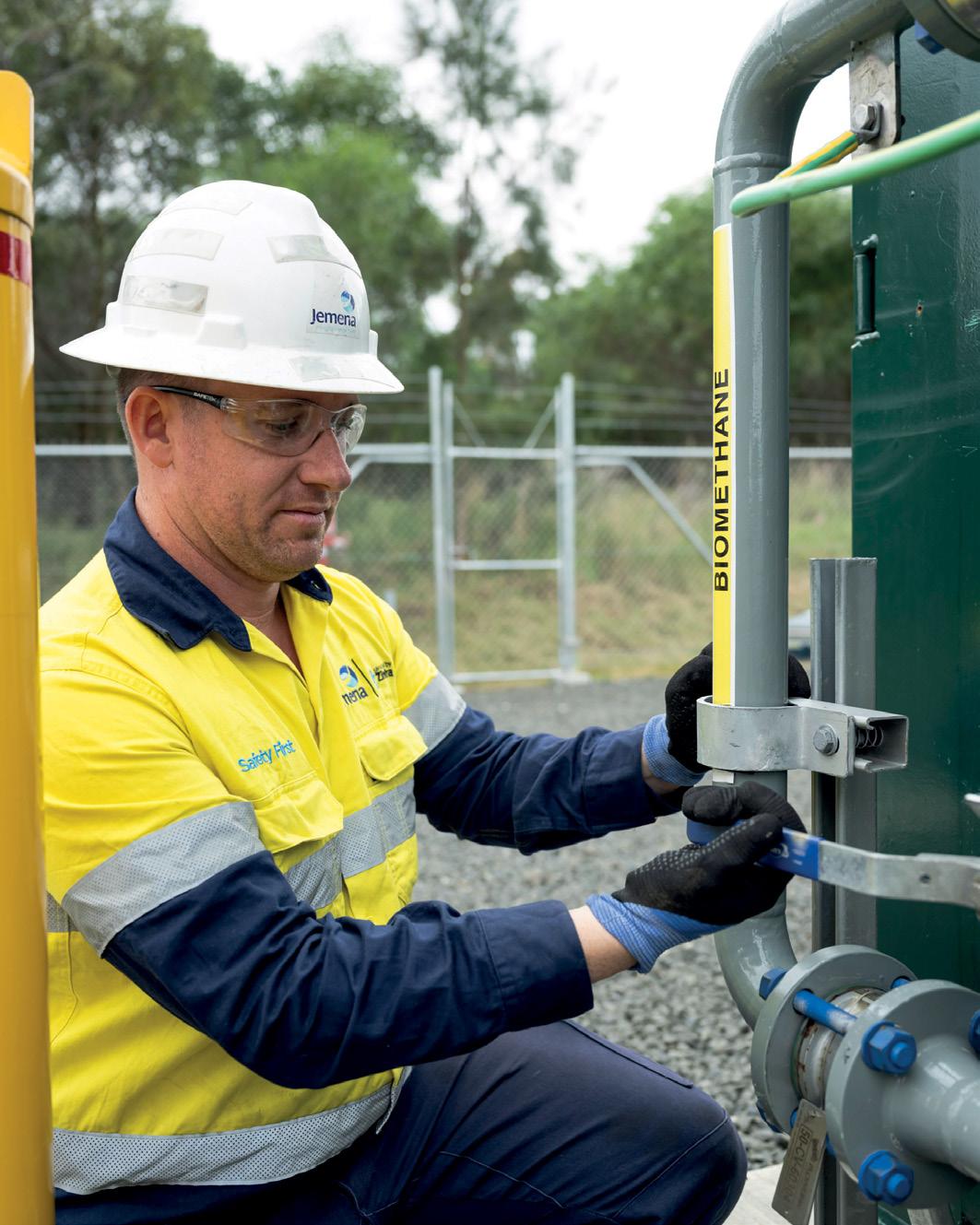
“A hybrid energy system, where we continue to use Australia’s extensive gas networks to transport increasing volumes of renewable gas, as a complement to renewable electricity, could see Australia reaching its net zero targets more affordably, sustainably and securely.”

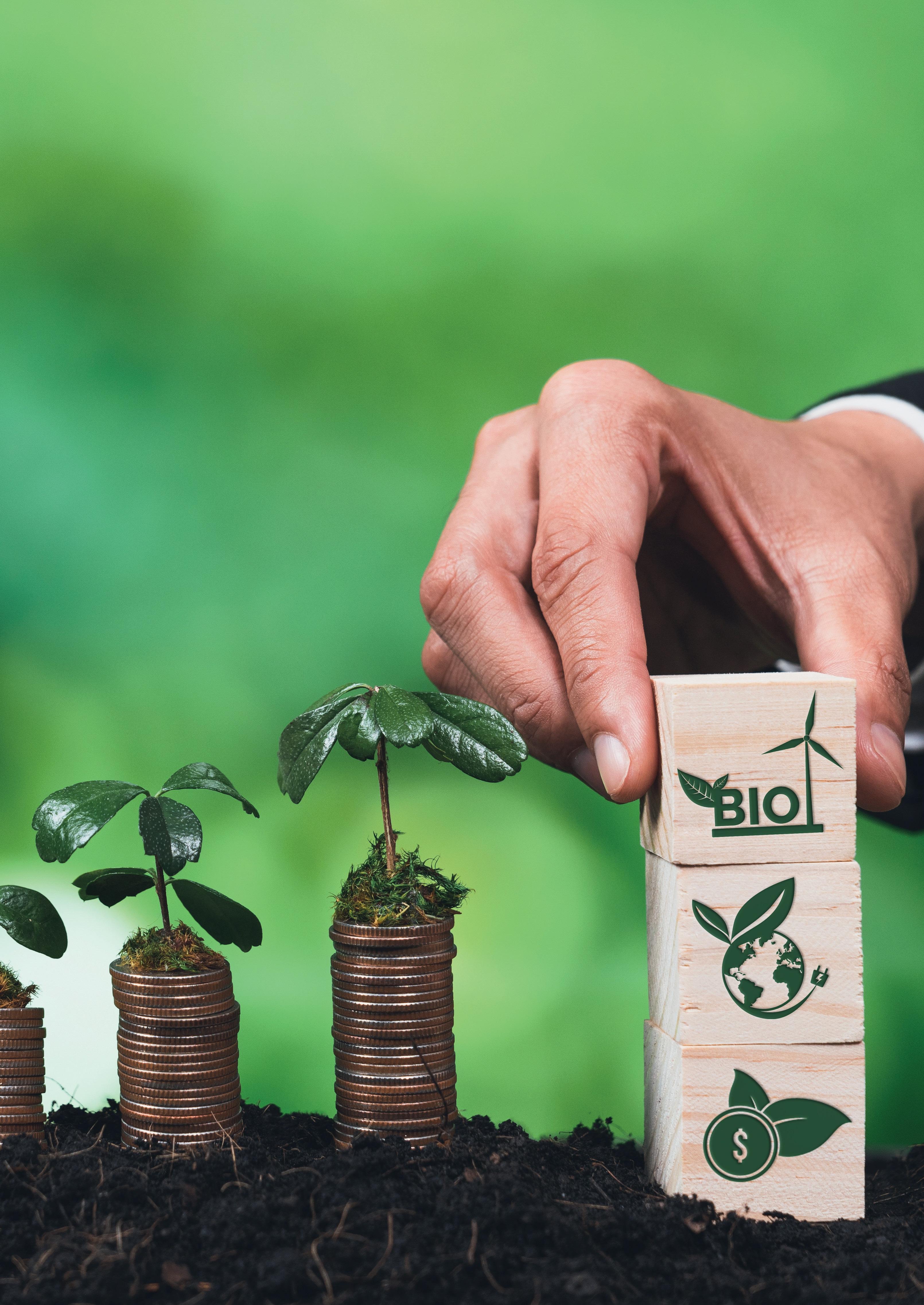

How do you decarbonise hard-to-abate sectors and ensure the solution is affordable and practical in both the short and long term? One solution to this question has been posed by Bioenergy Australia, a leading organisation advocating to integrate liquid bio and future fuels into Australia’s energy mix as the national net zero targets loom closer. Its 2023 report, Transitioning Australia’s liquid fuel sector: the role of renewable fuels, provides pivotal insight into the incredible economic and environmental opportunity renewable fuels present for Australia and how they can play a key role to decarbonise the transport sector.
Building on the 2020 Australian Renewable Energy Agency (ARENA) report, Australia’s Bioenergy Roadmap, the new release by Bioenergy Australia furthers the research and offers recommendations for government actions to grow the production and utilisation of renewable fuels to support, not only net zero, but the potential for a booming biofuels industry.
Bioenergy Australia CEO, Shahana McKenzie, said electrification can only be part of the answer to reducing emissions.
“Australia’s economy is reliant on liquid fuels. Our heavy industries, aviation, marine, agriculture, and mining need affordable and immediate decarbonisation options,” Ms McKenzie said.
“Touting electrification as the only solution is naïve and delays a robust discussion about how we achieve decarbonisation of these hard-to-abate sectors.”
With liquid renewable fuels seeing global investment more than double in 2021, reaching approximately $10.5 billion, there are significant opportunities for Australia including replacing and decarbonising key transport and industrial sub-sectors while supporting regional development, improved waste management, export growth and the promotion of domestic fuel security.
In 2022, transport averaged around 19 per cent of Australia’s total emissions. However, the Department of Climate Change, Energy, the Environment and Water (DCCEEW) have estimated this is likely to increase and “without intervention, the transport sector is projected to be Australia’s largest source of emissions by 2030”.
Part of the transport solution is electric vehicles, but biofuels can present both short and long-term solutions for decarbonising the sector.
Biofuel, in its current production and with current infrastructure, cannot be so easily adapted. It is generally only used as in petrol at a mix of around five per cent. Higher mixes of biofuel are not compatible with current infrastructure. Advanced or renewable diesel is synthetically refined, and thus able to be a direct replacement.
Bioenergy Australia reported that replacing a mere six per cent of petrol with bioethanol would be the equivalent of taking 730,000 vehicles off the road.
Sustainable aviation fuel (SAF) has a huge potential to reduce airport transport emissions. Based on Qantas’ target to replace ten per cent of jet fuel with SAF, it would be the equivalent of around 220 million less kilometres flown annually by a Boeing 747.
There remain several challenges to the uptake of renewable fuels but Bioenergy Australia is confident these can be overcome
with a coordinated approach to industry development. Generally speaking, Australia doesn’t have encouraging incentives in place to support a domestic biofuels production boom.
There are several key pieces of government support that can help generate a biofuels industry in Australia regarding tax credit policies and emission levers.
An integrated policy lever regarding carbon or greenhouse gas (GHG) emissions would support decarbonising the transport fuels sector, without enforcing a cap on emissions themselves. Instead, these standards set targets in relation to the gram of carbon dioxide per megajoule of energy supplied over a baseline year. Standards such as these, already in effect in the US as early as 2007, also allow differing emission intensity values from different production pathways to vary, allowing for greater accuracy. Standards in Australia will help legislate greater emission reductions and encourage a move to renewable fuels in the transport sector.
To help grow the infrastructure to meet booming demand and potential, greater capital grant funding sources, or subsidies for biofuels would encourage new projects and developments. Bioenergy Australia suggests that tax credits could be on a per litre basis for both the production of renewable fuels and for the blending of them. A defined range could offer variability for the level of emission intensity depending on the fuel type, providing greater and specific incentives.
Due to its current commercial limitations, the cost of producing renewable fuels is a large barrier for its integration into Australia’s fuel economy. The cost is currently more than traditional fossil fuels, and producing it means higher costs for its users. Bioenergy Australia also said the current subsidies available for conventional fossil fuels distort the market competition, suggesting it’s also likely to be impacting the willingness of consumers to sign on to utilise biofuels.
Creating availability and access to feedstock would also support higher utilisation of the resource to high value users, and more affordable access will help reduce the cost of renewable fuels.
There are a number of countries committing to renewable fuels with new policies, significant investments and increased incentives to help propel their domestic biofuel industries.
The US Inflation Reduction Act has allocated USD$500 million for grants, covering up to 75 per cent of biofuels infrastructure projects and includes an increase of credits available to biofuel, biodiesel and even SAF. SAF does have greater limitations compared to the available biodiesel credits, such as SAF produced
by non-biomass methods being excluded from credit opportunities.
To the north of the US, Canada’s Clean Fuels Fund is a CAD$1.5 billion government initiative to support domestic low-carbon fuel production. It has further support for biofuel feedstock providers, creating major opportunities for domestic growth and their export capabilities. The Canadian fund is also backed by a matching legislation, the Clean Fuel Regulations, which limits emissions by oil and gas.
Brazil’s Renovabio program is a specialised R$1 billion loan program for carbon reduction projects under the National Biofuels Policy (RenovaBio). In effect from December 2019, it provides Brazil an important pathway to reduce GHG emissions and reach the Paris Climate Agreement. RenovaBio provides Environmental, Social and Governance (ESG) credits for the biofuels industry, including providing companies who reach their CO2 emission reduction targets lower interest rates. The program is estimated to reduce the release of 600 million tonnes of carbon dioxide across ten years, while supporting renewable fuels in the nation’s transport sectors.
International strategies should be utilised as inspirations and showcase how ignoring the potential of biofuels would have dramatic impacts on Australia’s place in the energy sector.
Queensland has been home to a biorefinery pilot plant since 2018. The Mercurius Australia plant is based at the Queensland University of Technology’s Renewable Biocommodities Pilot Plant and turns sugar cane into liquid biofuels. The plant has been helping the university pioneer research and new biofuel developments.
Another major project under proposal is the Queensland Gladstone biorefinery project by Oceania Biofuels, a $500 million project set to produce biofuels from feedstock. The project development is underway, with construction having commenced in January 2023. Oceania Biofuels CEO, Mike Everton, said by 2025, the plant should be able to produce more than 350 million litres of renewable biofuels per year.
Across the country, bp has also been undergoing major transitions to biofuels thanks to its new biorefinery and energy hub. Located in Western Australia, the Kwinana Energy Hub is one of five global bp biofuel projects. The five projects combined are forecasted to produce 50 thousand barrels of SAF and renewable diesel per day by 2030. The Australian hub, a first of its kind for the company globally, is planning to produce SAF and biodiesel from biofeedstock by 2026.
Bp said the hub is also assessing the feasibility of integrating green hydrogen production operations as engineering plans are progressing at the site.
Frédéric Baudry, bp President Australia and SVP fuels and low carbon solutions Asia Pacific said, “Kwinana illustrates the power of the Australian economy and its ability to reinvent itself for the energy transition.”
The energy sector is undergoing rapid change, but supporting a biofuels industry could provide a major economy boost and help decarbonise hard-to-abate sectors at the same time.

“The market is looking for a strong regulatory signal from Australian governments; the necessary green light for investors, producers and refiners,” Ms McKenzie said.
“Without a domestic renewable fuels sector, Australia is exposing itself to the world’s next energy supply shock and the higher prices that would accompany such a crisis.”
While traditional trade publications have quality audiences and high levels of trust, they can lack the full range of services to guarantee a return on your investment. And while traditional marketing agencies offer the latest marketing techniques, they don’t have the audience or the industry understanding the B2B sector needs.
Monkey Media is the missing link that brings together a trusted brand and powerful audience, with a complete agency offering.

As leading multinational designers and manufacturers of innovative power transmission products, the brands of Regal Rexnord offer many critical drivetrain solutions for a wide range of renewable energy applications.


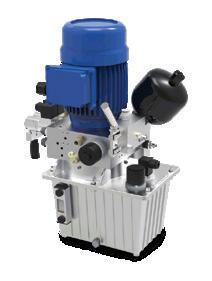

Service Support by Trained Technicians
Specialist Tooling for Maintenance

Geniune OEM Spare Parts


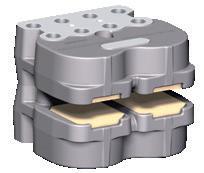
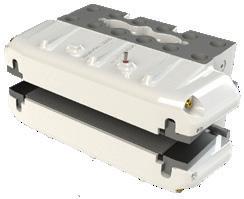


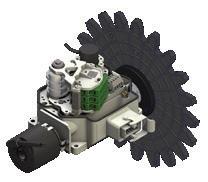
Local Spares Stocking Program
